Commission, December 21, 2017, No M.8633
EUROPEAN COMMISSION
Decision
LUFTHANSA / CERTAIN AIR BERLIN ASSETS
To the notifying party:
Dear Sir or Madam,
Subject: Case M.8633 – LUFTHANSA / CERTAIN AIR BERLIN ASSETS Commission decision pursuant to Article 6(1)(b) in conjunction with Article 6(2) of Council Regulation No 139/20041 and Article 57 of the Agreement on the European Economic Area2
1. INTRODUCTION
(1) On 31 October 2017, the European Commission received notification of a proposed concentration pursuant to Article 4 of the Merger Regulation by which Deutsche Lufthansa AG ("Lufthansa", Germany) would acquire within the meaning of Article 3(1)(b) of the Merger Regulation control of the whole of NIKI Luftfahrt GmbH ("NIKI", Austria) and Luftfahrtgesellschaft Walter mbH ("LGW", Germany), by way of purchase of shares from Air Berlin plc ("Air Berlin").3 Prior to the closing of the acquisition, additional aircraft, crew and an airport slot4 package would be transferred from Air Berlin to LGW. These operations were to take place in the context of Air Berlin's insolvency proceedings, initiated on 15 August 2017.
(2) On 13 December 2017, Lufthansa decided not to acquire NIKI, pursuant to a clause in the sale and purchase agreement allowing Lufthansa to exclude, inter alia, NIKI from the acquisition, notably if, in Lufthansa's reasonable assessment, the acquisition would not be approved by the relevant competition authorities by 29 December 2017.5 As a result of this modification, the proposed concentration no longer included the acquisition of NIKI, but only the acquisition by Lufthansa of all shares in LGW and of additional aircraft, crew and an airport slot package that would be transferred from Air Berlin to LGW prior to closing (the "Transaction"). Lufthansa and LGW are collectively referred to as the "Parties".
(3) The slots that would be transferred by Air Berlin to LGW and, subsequently, to Lufthansa include slots at Zurich airport, thus affecting air transport in Switzerland. The bilateral Agreement between the European Union and the Swiss Confederation on Air Transport ("the ATA")6 gives the Commission the power to control concentrations between undertakings which may affect air transport in Switzerland.
2. THE PARTIES
(4) Lufthansa is the holding company of Lufthansa Group which is headquartered in Cologne, Germany. Lufthansa's passenger air transport business includes Lufthansa Passenger Airlines, Swiss International Air Lines Ltd., Brussels Airlines S.A./N.V., Austrian Airlines AG ("Austrian"), Air Dolomiti S.p.A., Eurowings GmbH ("Eurowings"), Germanwings GmbH ("Germanwings"), Edelweiss Air AG and SunExpress Deutschland GmbH ("SunExpress").7
(5) Lufthansa is also a member of Star Alliance,8 which includes Adria Airways, Aegean Airlines, Air Canada, Air China, Air India, Air New Zealand, All Nippon Airways, Asiana, Austrian Airlines, Avianca, Brussels Airlines, Copa Airlines, EgyptAir, Ethiopian Airlines, EVA Air, LOT Polish Airlines, Scandinavian Airlines, Shenzhen Airlines, Singapore Airlines, South African Airways, Swiss International Air Lines, TAP Portugal, Thai Airways, Turkish Airlines and United Airlines.
(6) Lufthansa is Germany's, Austria's and Switzerland's largest airline by both passenger numbers and revenue and it is Europe's largest airline by revenue. It operates flights to 301 destinations in 100 countries, with a fleet of about 600 aircraft. Lufthansa's principal hubs for international operations are at Brussels, Frankfurt, Munich, Vienna and Zurich airports. Lufthansa also has a number of bases across the world. In 2016, Lufthansa carried approximately 109.6 million passengers.
(7) LGW is a wholly-owned subsidiary of Air Berlin, which was Germany's second-largest airline, after Lufthansa. Air Berlin filed for insolvency on 15 August 2017 and ceased operations on 28 October 2017. Although Air Berlin entered into insolvency proceedings on 15 August 2017, its subsidiaries LGW and NIKI did not. LGW is still solvent, while NIKI9 filed for insolvency on 13 December 2017.
(8) LGW is headquartered in Dortmund, Germany, and operated 18 Dash 8 Q400 turbo-prop aircraft that were wetleased to Air Berlin and served short-haul routes into Duesseldorf and Berlin Tegel airports. LGW's role in the Air Berlin group was primarily to provide feeder traffic for Air Berlin's short and long-haul operations. Its aircraft were deployed where demand was not sufficient for larger aircraft, be it because of limited overall traffic on the route or because demand for a particular time (e.g. in the early afternoon) was limited. On 28 October 2017, when Air Berlin ceased its operations, LGW stopped operating its aircraft as a wetlessor for Air Berlin.
3. THE OPERATION
(9) On 13 October 2017, Lufthansa entered into an agreement to purchase all shares in LGW and NIKI and other assets and rights from Air Berlin.10 As explained in paragraph 2, on 13 December 2017, the scope of the acquisition was modified and, as a result, the Transaction was limited to the acquisition by Lufthansa of all shares in LGW and the additional aircraft, crew and airport slots that would be transferred to LGW prior to closing.
(10) Prior to closing of the acquisition, Air Berlin would transfer to LGW up to […] A320 aircraft and corresponding crew, as well as airport slots at notably Duesseldorf, Hamburg, Munich, Berlin Tegel and Zurich airports, which are further described in the next paragraph. As a result of the Transaction, Lufthansa would also acquire the aircraft, crew and airport slots that would have thus been transferred to LGW.11
(11) The slots that would be transferred by Air Berlin to LGW are slots for the Winter 2017/18 IATA12 Season and the Summer 2018 IATA Season. They consist of two different groups of slots. One group is made up of the slots that were held by Air Berlin but used by LGW for its flights with the Dash 8 Q400 turbo-prop aircraft before Air Berlin ceased operations on 28 October 2017 (the "LGW slots"). The second group is made up of some of the slots that were held by Air Berlin and used by Air Berlin (not LGW) on various routes, including in particular slots at Duesseldorf and Berlin Tegel airports, before Air Berlin ceased its operations (the "surplus slots").
(12) According to Lufthansa, the acquisition of LGW is designed to ensure continuity of the cooperation between Air Berlin and Lufthansa (through its subsidiaries Eurowings and Austrian) under the wetlease agreement established in December 2016 (the "Roof Wetlease"). Under the Roof Wetlease, Air Berlin is leasing a total of […] crewed aircraft to Eurowings ([…] aircraft) and Austrian ([…] aircraft). In addition, Air Berlin leases […] spare aircraft to Eurowings. The Roof Wetlease did not confer any slots or other assets to Lufthansa in relation to these […] aircraft. The overall term of the Roof Wetlease was intended to run for up to […] years. Under the Transaction, LGW will be the vehicle which will continue to operate the flight programme currently served under the Roof Wetlease.13
4. THE CONCENTRATION
(13) As a result of the Transaction, Lufthansa would acquire sole control over LGW and the aircraft, crew and slots that have been transferred to it. LGW is a legal entity which operates aircraft and has an operating licence, including an air operator's certificate (AOC), allowing it to operate these aircraft. LGW did not hold any slots but used Air Berlin's slots for its operations. However, the slots transferred to LGW by Air Berlin, together with the other transferred assets and resources, would form part of the undertaking that would, subject to compliance with the Slot Regulation, be acquired by Lufthansa. Together, the legal entity LGW and the assets, resources and rights transferred to it prior to closing constitute a business with a market presence, to which a market turnover can clearly be attributed. LGW and the additional aircraft, crew and slots that would be transferred to it thus constitute an undertaking or part of an undertaking within the meaning of the Merger Regulation.
(14) The Transaction therefore constitutes a concentration within the meaning of Article 3(1)(b) of the Merger Regulation.
(15) On 10 October 2017, Lufthansa requested, pursuant to Article 7(3) of the Merger Regulation, a derogation from the suspension obligation provided for in Article 7(1) of the Merger Regulation. More specifically, Lufthansa requested that it be allowed to replace Air Berlin as dry lessee of several aircraft (or to purchase them), to avoid that the lessors of these aircraft would repossess the aircraft because of Air Berlin's failure to pay the amounts due under the lease agreements. In addition, Lufthansa requested that it be allowed to enter into wetlease agreements with LGW and NIKI as lessors and Lufthansa as lessee. This way, LGW and NIKI would be able to perform the services performed by Air Berlin under the Roof Wetlease.
(16) On 27 October 2017, the Commission granted a derogation on the basis of Article 7(3) of the Merger Regulation, subject to conditions aimed at ensuring that the measures taken by Lufthansa would not negatively affect NIKI and LGW or make it more difficult for NIKI and LGW to be sold, in whole or in parts, to any other buyers, should this happen in the future.14
5. EU DIMENSION
(17) The undertakings concerned have a combined aggregate world-wide turnover of more than EUR 5 000 million (Lufthansa: EUR 31 660 million; LGW and NIKI combined: EUR […] million).15 Each of them has an EU-wide turnover in excess of EUR 250 million (Lufthansa: EUR […] million; LGW and NIKI combined: EUR […] million),16 and they do not achieve more than two-thirds of their aggregate EU-wide turnover within one and the same Member State.
(18) The Transaction therefore has an EU dimension within the meaning of Article 1(2) of the Merger Regulation.
(19) On 13 December 2017, Lufthansa decided not to acquire NIKI. The Transaction therefore changed from an acquisition of control over LGW and NIKI to an acquisition of control over LGW alone. The Transaction, which was modified by Lufthansa after the notification, remains within the Commission's jurisdiction. It follows from the principles underlying the Merger Regulation (importantly, the principle of a clear division of competences between the authorities of the Member States and the Commission), that partial amendments to the contemplated transaction occurring after the notification of a transaction cannot require the Commission to re-examine its competence. As the Court of Justice has ruled,
"the competence of the Commission to make findings in relation to a concentration must be established, as regards the whole of the proceedings, at a fixed time. Having regard to the importance of the obligation of notification in the system of control put in place by the Community legislature, that time must necessarily be closely related to the notification of the concentration." 17
(20) This avoids that the Commission's competence, once established, can be challenged at any time or be in a state of constant flux.18
(21) According to the Commission's Consolidated Jurisdictional Notice, the relevant date for establishing the Commission's jurisdiction over a concentration is the date of the conclusion of the binding legal agreement, the announcement of a public bid or the acquisition of a controlling interest or the date of the first notification, whichever date is earlier.19 Since the Transaction had an EU dimension at the time of the conclusion of the agreement, the Commission has jurisdiction to assess the Transaction. The change in the scope of the Transaction which occurred on 13 December 2017 does not deprive the Commission of its jurisdiction.
6. DESCRIPTION OF LGW'S ACTIVITIES
(22) According to Lufthansa, the proposed acquisition of LGW has different objectives: (i) the discontinuation of the services that LGW provided to Air Berlin and the replacement of Air Berlin by LGW in the framework of the Roof Wetlease between Air Berlin and Lufthansa;20 (ii) the permanent integration of the aircraft and crew deployed under the Roof Wetlease into Lufthansa; and (iii) the takeover of an additional slot package (the LGW slots and the surplus slots).21
(23) Prior to the Transaction, LGW operated as a wetlease provider for Air Berlin, and thus mainly acted as a production platform within the Air Berlin Group.22 The slots used to operate the flights were held by Air Berlin and the tickets for those flights were marketed and sold by Air Berlin. This means that Air Berlin had a position on the markets (routes) for passenger air services, while LGW was active on the market for the wetleasing of aircraft, although on an intra-group basis only.
(24) As a result of the grounding of Air Berlin's fleet on 28 October 2017, Air Berlin lost its position on the markets for passenger air services. LGW no longer operated as an in-house wetlessor for Air Berlin, but continued its activities, this time as wetlessor on the merchant market, replacing Air Berlin as Lufthansa's wetlessor. LGW thus operated Eurowings' flights previously performed by Air Berlin under the Roof Wetlease. For that purpose, Lufthansa requested and was granted by the Commission a derogation from the standstill period under Article 7(3) of the Merger Regulation on 27 October 2017, the day before the grounding of Air Berlin. The derogation was granted subject to conditions to preserve NIKI and LGW, in case the whole or parts of NIKI or LGW would be acquired by any other purchaser than Lufthansa.23
(25) In view of the above, the Commission considers that prior to, and independently of, the Transaction, Air Berlin and LGW had ceased to operate on, respectively, the markets for passenger air transport and for wetleasing of aircraft. Moreover the entering into the wetlease agreement between Lufthansa and LGW has a very limited impact on these two markets, to the extent that it replaces the Roof Wetlease that was already in place between Lufthansa and Air Berlin.
(26) In this context, the integration of the aircraft and crew assigned to the continuity of the Roof Wetlease, via the acquisition of LGW, has a very limited impact on the markets for passenger air transport and wetleasing of aircraft compared to the situation which prevailed pre-Transaction under the Roof Wetlease. Moreover, the Roof Wetlease has been examined and approved under German merger rules by the German Federal Cartel Office.24 The Commission therefore considers that it is not necessary, for the purpose of this Decision, to further assess the acquisition by Lufthansa, via LGW, of aircraft and crew assigned to the Roof Wetlease (or to the wetlease agreements that Lufthansa has entered into for the strict replacement of the Roof Wetlease).
(27) However, the transfer of slots through the acquisition of LGW is unrelated to the Roof Wetlease, which is operated with Eurowings slots only.25 This holds true for both (i) the LGW slots, which are held by Air Berlin and used on routes operated by LGW, and (ii) the surplus slots, which are held by Air Berlin and used on routes operated by Air Berlin (and not LGW) prior to Air Berlin's termination of its operations. Therefore, the structural effects on competition brought about by the Transaction stems from the transfer of slots from Air Berlin to Lufthansa.
7. ANALYTICAL FRAMEWORK
(28) Proper examination of the competitive effects of a transaction under the Merger Regulation rests in particular on a sound understanding of (i) the competitive constraints under which the merged entity will operate, and (ii) the specific causal effects of the transaction on the development of competition in the market.
(29) Along those lines, and taking account of the forward-looking nature of merger control, the Commission will, as an introduction, describe the EU slot system (section 7.1). Next, it will define the relevant markets (section 7.2). The Commission will then determine the circumstances likely to prevail on the relevant markets absent the Transaction (the relevant "situation absent the Transaction", section 7.3).
(30) The Transaction relates to passenger air transport, considering that (i) Lufthansa provides passenger air transport services, and (ii) LGW, to which additional aircraft, crew have been transferred prior to closing, is used as a vehicle for the transfer of slots (see section 6), which are essential to operate air transport services.
7.1. Introduction
(31) The Commission will describe the relevance of slots as an input for air transport services (section 7.1.1) and the EU rules that govern their allocation at EU airports (section 7.1.2).
7.1.1. Slots as an input for air transport services
(32) By virtue of the Slot Regulation, slots, i.e. the permission to land and take-off at a specific date and time at congested airports, are essential for airlines' operations. Indeed, only air carriers holding slots are entitled to get access to the airport infrastructure services delivered by airport managers and, consequently, to operate routes from or to those airports.
(33) The Commission has, in its prior decision practice on mergers involving air carriers, highlighted that the lack of access to slots constitutes a significant barrier to entry or expansion at Europe's busiest airports.26
(34) The Commission has also insisted, in the framework of its airport policy, that "slots are a rare resource" and "access to such resources is of crucial importance for the provision of air transport services and for the maintenance of effective competition."27
(35) In addition, the Slot Regulation recalls that, with the increase of air traffic, there is a continuously growing demand for capacity at congested airports.28 Therefore, the lack of available slots has become a prominent feature of the EU airline industry and is expected to become an even more critical issue for air carriers in the near future.
7.1.2. Rules for the allocation of slots
(36) In the context of imbalance between demand and supply of airport capacity, the Slot Regulation defines the rules for the allocation of slots at EU airports. It aims at ensuring that, where airport capacity is scarce, the latter is used in the fullest and most efficient way and slots are distributed in an equitable, non-discriminatory and transparent way.
(37) Under the Slot Regulation, the general principle regarding slot allocation is that an air carrier having operated its particular slots for at least 80 % during the summer or winter scheduling period is entitled to the same slots in the equivalent scheduling period of the following year (the "grandfather rights").29 Consequently, slots which are not sufficiently used by air carriers are reallocated (the "use it or lose it" rule).
(38) The Slot Regulation also provides for the setting up of "pools" containing newly-created time slots, unused slots and slots which have been given up by a carrier or have otherwise become available. 50% of the slots from the slot pool shall be first offered to new entrants. The other 50% of the slots from the slot pool shall be placed at the disposal of other applicant airlines (incumbent airlines). If applications by new entrants amount to less than 50% of the capacity made available through slots from the pool, this remaining capacity shall also be placed at the other applicants' disposal.30
(39) Under the Slot Regulation, slots cannot be traded. They may however be exchanged or transferred between airlines in certain specified circumstances. If the Transaction is consummated, the transfer of slots from Air Berlin to Lufthansa could, subject to the explicit confirmation from the coordinator under the Slot Regulation,31 take place in the framework of this exception.
7.2. Relevant markets
(40) The Commission will first address the relevance of the markets, defined in previous cases as passenger air transport on city pairs, for the Transaction in the light of the fact that the Transaction concerns the transfer of slots from a bankrupt air carrier (section 7.2.1). Second, the Commission will define the markets relevant for the assessment of the Transaction (section 7.2.2).
7.2.1. Relevance of markets defined as passenger air transport on city pairs
(41) The Commission has, in its prior decision practice related to airlines, defined the relevant market for scheduled passenger air transport services on the basis of the "point of origin/point of destination" ("O&D") city-pair approach.32 Under the O&D approach, every combination of an airport or city of origin to an airport or city of destination is defined as a distinct market. The effects of a transaction on competition are thus assessed for each O&D separately.
(42) Lufthansa submits that it intends to use the slots to be transferred in the context of the Transaction to implement its growth plans and that it will not in any sense take over the flights that Air Berlin used to operate.33 Therefore, Lufthansa considers that, at least as far as the surplus slots are concerned, the Transaction does not give rise to affected markets corresponding to the routes on which Air Berlin happened to use the slots.34
(43) A number of respondents to the market investigation indicate that the traditional O&D approach is not sufficient to fully address the effects of the Transaction.35 In particular, some competitors point to the necessity to address the reinforcement of Lufthansa's position at airports, submitting that "a comprehensive approach shall also include the assessment of the entire market strength of an airline at any respective airport (…);" "[a]n approach which also takes into account local effects at certain airports, separated from a view on certain routes, should be used;" or "[b]esides the O&D approach, it might be necessary to assess also the overall share (or share’s increases) of Lufthansa Group’s operations in each of the airports."36
(44) The Commission considers that the traditional O&D approach, under which each O&D city-pair is assessed separately, would fail to capture the structural effects on competition brought about by the Transaction, in view of (i) the termination of Air Berlin's (including LGW's) operations prior to the Transaction, hence its exit from all O&D markets, and (ii) the fact that LGW is used in particular as a vehicle for the transfer of Air Berlin's slots.
(45) First, Air Berlin ceased its flight operations prior to the Transaction and exited all the routes on which it used the slots forming part of LGW. As a consequence, LGW also exited the routes on which it deployed its fleet on behalf of Air Berlin. Such a situation is independent of the Transaction and it is highly unlikely that Air Berlin or LGW would resume operations.
(46) Considering that Air Berlin and LGW, prior to and independently of the Transaction, stopped their activities as air carriers, it would be inappropriate in the present case to use an analytical framework designed to address the loss of O&D competition following the merger between two air carriers.
(47) In prior airline cases for which the target was expected to discontinue its operations absent the transaction but had not stopped its operations pre-transaction, the Commission assessed both the route-by-route effects of the transaction (as justified by the on-going operations of the target air carrier) and the transaction's impact on the competitive threat posed by other carriers, which is not necessarily linked to specific routes.37 Thus, in those cases, the Commission also performed a detailed analysis of the impact of the transaction on the distribution of slots at each congested airport and, therefore, of the impact of the transaction on all the markets (i.e., aggregating all routes) for passenger air transport from or to the congested airport.38
(48) Second, the Transaction mainly entails the transfer of slots. As explained in section 7.1.1, slots are attached to an airport but are not attached to any specific route. This is particularly clear in this case considering that Air Berlin and LGW do not use those slots anymore on any route. Consequently, the Transaction entails the transfer to Lufthansa of certain inputs (i.e. slots) needed to operate routes from or to certain airports, without limiting Lufthansa to use these inputs on specific routes. In this regard, a respondent to the market investigation notes that the appropriateness of the O&D approach "depends on whether the slots and capacity continue to be allocated in future in the same way as they were under Air Berlin." Another air carrier believes that "the O&D approach is a less appropriate way to assess the effects of the Transaction than an approach by airport." It provides the following example of two different routes served from Berlin Tegel airport, illustrating that, although the barriers to enter or expand on these two routes are the same, an O&D assessment would result in diverging conclusions: "Whereas the route TXL-PMI [Berlin Tegel-Palma de Mallorca] could be considered problematic under the “O&D” approach regarding the competitive situation, the route TXL-VAR [Berlin Tegel-Varna] might appear less problematic. In general, an airport slot can be used for any kind of service and is not bound to a certain route. Nevertheless, an operation on the route TXL-VAR [Berlin Tegel-Varna] would be very difficult due to the slot situation and other dominance effects in TXL [Berlin Tegel]."39
(49) In light of the above, considering that Air Berlin and LGW exited all the routes and that the Transaction primarily relates to slots, that is to say the right to operate at airports, the Commission considers that the Transaction does not result in the take-over by Lufthansa of Air Berlin's or LGW's position on any specific routes. Therefore, the Commission will not carry out an O&D assessment of the effects of the Transaction.
(50) By contrast, the Transaction results in the take-over by Lufthansa of Air Berlin and LGW's positions at certain airports, corresponding to the slots, i.e. the rights to operate flights from or to airports, that have been transferred to LGW before their transfer to Lufthansa.
7.2.2. Markets relevant for the assessment of the transfer of slots
(51) According to the Explanatory Memorandum for the Commission Proposal for a Regulation of the European Parliament and of the Council on common rules for the allocation of slots at European Union airports,40 "the emergence of a strong competitor at a given airport requires it to build up a sustainable slot portfolio to allow it to compete effectively with the dominant carrier (usually the “home” carrier)."
(52) In this context, as regards the transfer of slots, the Commission has previously aggregated all routes originating or terminating in an airport for the purpose of defining the relevant situation absent the Transaction.41
(53) Accordingly, the Commission has assessed the impact of the Transaction in terms of Lufthansa's resulting slot holding in relation to the markets for passenger air transport services from or to the relevant airports (section 7.2.2.1). On these markets, the Parties, as slot holders, are both present on the supply side.
(54) In addition, slots relate to air carriers' ability to operate flights from or to the relevant airports, since air carriers, through slots, get access to airport infrastructure, notably to the available runway and terminal capacity, so that there is a market for airport infrastructure services to airlines. On this market, the Parties are both present on the demand side (section 7.2.2.2).
7.2.2.1. Passenger air transport services
(a) Product market
(55) In several prior decisions, the Commission has considered the effects of a transaction on the flight operations of air carriers at an airport, without distinguishing between the specific routes served from or to that airport. Such an approach has notably been adopted to assess the risks of foreclosure entailed by a concentration between an airport manager and an air carrier at Prague airport,42 or the effects of the strengthening of an airline's position at Heathrow airport.43
(56) In those decisions, the Commission has not deemed it necessary to consider the same distinctions as those considered when each O&D market is examined separately (e.g. time sensitive vs. non-time sensitive passengers, direct vs. indirect flights, charter flights vs. scheduled flights, air transport vs. train transport, wholesale vs. retail supply of airline seats, feeder traffic).44
(57) In this case, the Transaction results in a concentration of slots at certain airports in the hand of a single undertaking. As described in section 7.1.1, airline carriers need these slots in order to compete in the various O&D markets originating and arriving at a specific airport. The Transaction's impact on competition, if any, will therefore occur on the various O&D markets originating and arriving at the airport at which slots are acquired. For the purposes of assessing the Transaction, it is, however, not necessary to analyse each of these O&D markets separately.45 As will be explained in section 8.2, the Transaction potentially only has an impact on the ability of air carriers to operate on these markets in view of their access to slots. As mentioned before, these slots are not linked to specific routes and can be used to operate in any relevant O&D market.
(58) For the purpose of this Decision, the Commission therefore considers the markets for the provision of passenger air transport services from or to an airport taken together.
(b) Geographic market
(59) The Commission has, in its prior decision practice related to the definition of O&D markets, considered flights to or from airports with sufficiently overlapping catchment areas to be substitutable with each other (particularly if the airports serve the same main city).46 The evidence used to characterise airport substitutability includes inter alia a comparison of actual distances and travelling times to the indicative benchmark of 100 km/1 hour driving time, the outcome of the market investigation (views of the airports, the competitors, and other market participants), and the parties' practices in terms of monitoring.
(60) The Commission will assess the position of the Parties at each relevant airport to which the LGW and surplus slots relate, although it will not perform a traditional O&D analysis in this case. For the purposes of analysing the Transaction, it is necessary to consider whether some of the relevant airports are substitutable with other airports in view of their overlapping catchment areas.
Overview of the relevant airports
(61) The slots to be transferred to LGW for the purpose of its acquisition by Lufthansa relate to 11 airports in Germany, Austria and Switzerland47 and to 8 other EU airports.48 Of these 19 airports, 1449 are coordinated airports.50 The question of substitutability is relevant only for 7 airports, which serve cities or regions also served by at least one other airport.51 These airports are discussed below.
Substitutability of Berlin Tegel and Berlin Schoenefeld airports
(62) Berlin currently has two airports, Berlin Schoenefeld and Berlin Tegel, from which Lufthansa operates and to which the slots to be transferred through the Transaction relate. Berlin Tegel airport is scheduled to close when all Berlin flights move to the Berlin-Brandenburg International Airport, which is, in effect, an extension of Berlin Schoenefeld. However, Berlin-Brandenburg International Airport is still under construction.
(63) The Commission has found, in a prior decision, that Berlin Tegel and Berlin Schoenefeld airports are substitutable from the point of view of passengers.52

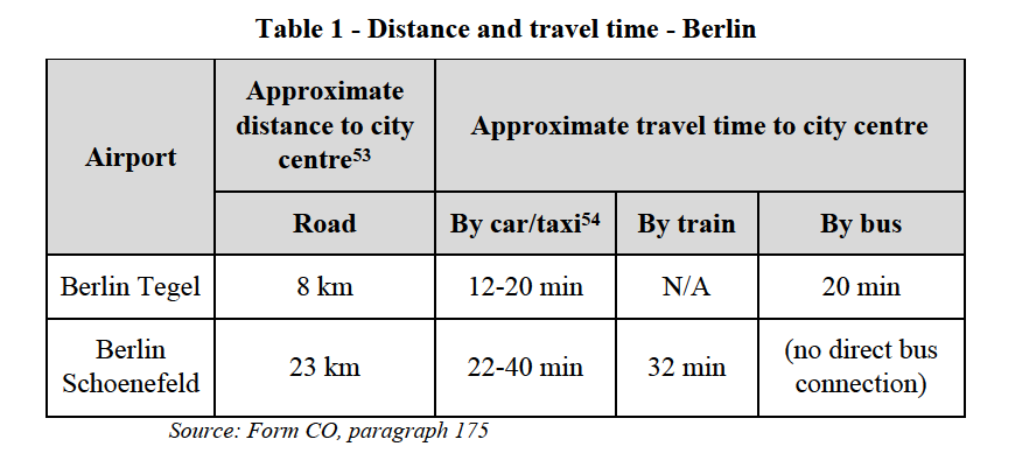
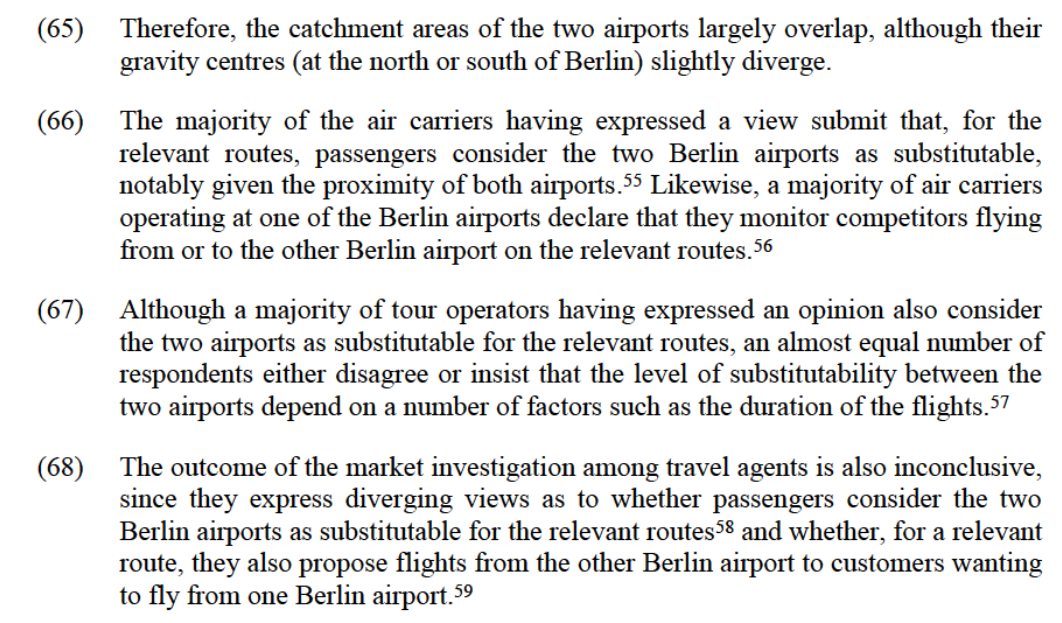
(69) Finally, the airport manager of the two Berlin airports indicates that the two airports have different customer bases.60
(70) In any case, for the purpose of this Decision, the question of whether Berlin Tegel and Berlin Schoenefeld airports belong to the same geographic markets for passenger air transport can be left open, as the Transaction would not raise serious doubts as to its compatibility with the internal market under either plausible market definition (see section 8.2.4.5).
Substitutability of Duesseldorf, Cologne-Bonn, Dortmund, and Weeze airports
(71) According to Lufthansa, the Rhine-Ruhr catchment area comprises at least four airports: Duesseldorf, Cologne-Bonn, Dortmund and Weeze.61 The slots to be transferred through the Transaction relate to Duesseldorf and Cologne-Bonn airports, while Lufthansa operates from Duesseldorf, Cologne-Bonn and Dortmund airports.
(72) In prior decisions, the Commission's assessment on whether Duesseldorf and Cologne-Bonn airports are substitutable depended on the type of passengers.62
(73) Taking Duesseldorf as the centre of the catchment area, the distances and travel times are as follows:
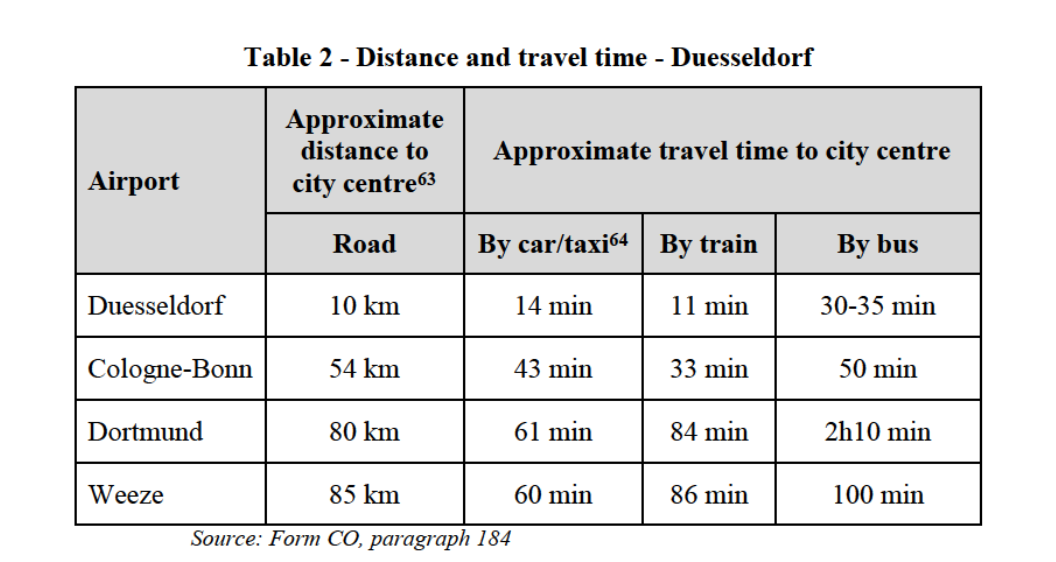

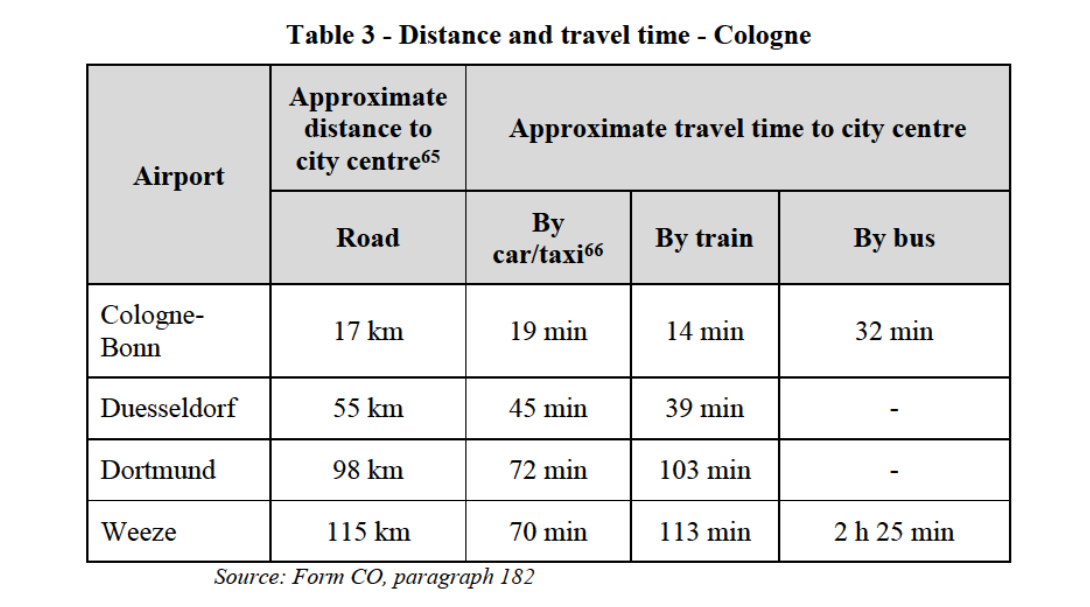

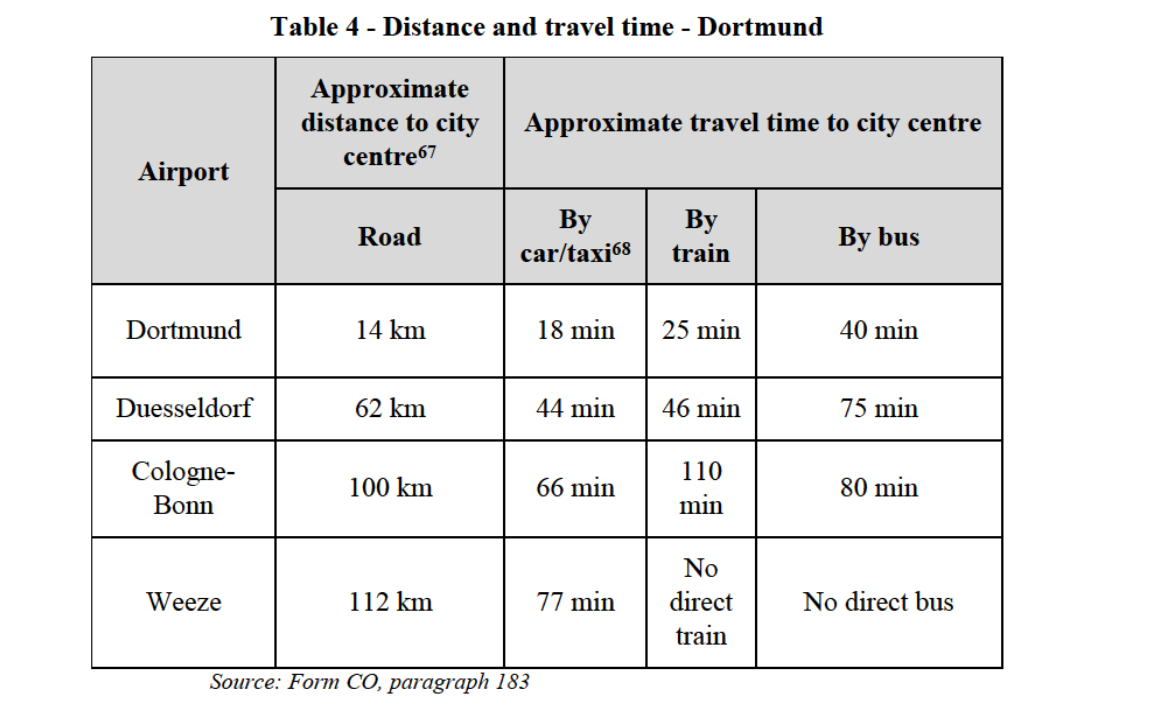
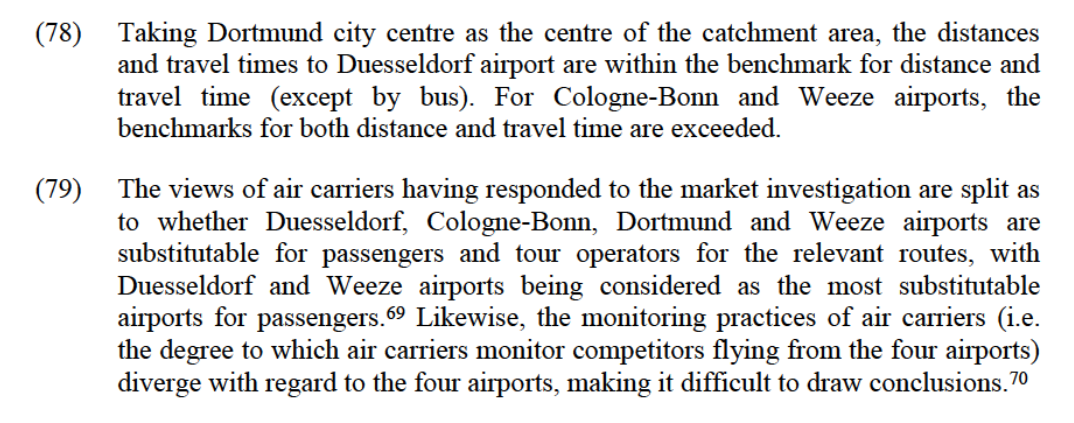
(80) The responses of airport managers are also inconclusive.71
(81) The results of the market investigation addressed to tour operators are more clear-cut. A majority of those having expressed an opinion do not consider any of the four airports as substitutable with another one for the relevant routes.72
(82) Similarly to tour operators, a minority of travel agents consider the different airports as substitutable with each other for the relevant routes and would propose, for a relevant route, flights from another airport to customers wanting to fly from either Duesseldorf, Cologne-Bonn, Dortmund or Weeze airport.73
(83) In any case, considering that, for the purpose of this Decision, the geographic scope of the market for airport infrastructure services to which slots give access is found to be limited to Duesseldorf airport (see section 7.2.2.2), the Commission's assessment of the impact of the Transaction on competition in the markets for passenger air transport services will be limited to Duesseldorf airport.
Substitutability of Munich and Memmingen airports
(84) According to Lufthansa, Munich airport and Memmingen airport are substitutable for the vast majority of passengers in the greater Munich region.74 Both Lufthansa's operations and the slots to be transferred through the Transaction relate to Munich airport.
(85) In two prior decisions, the Commission reached different conclusions depending on the routes, air carriers and customers. While Munich and Memmingen airports were found to belong to the same market for routes between Dublin and Munich,75 Memmingen airport was deemed unlikely to be substitutable to Munich airport, except for a very limited number of particularly non-time sensitive passengers.76
(86) Taking Munich as the centre of the catchment area, the distances and travel times are as follows:
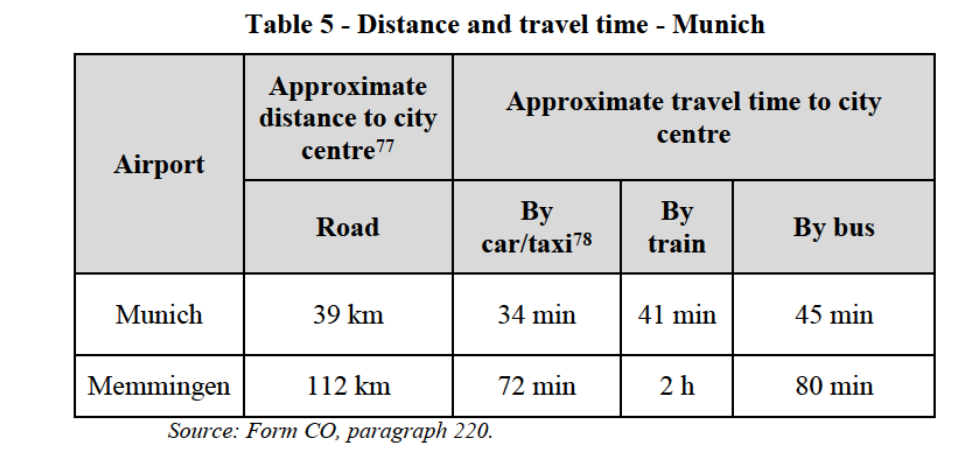
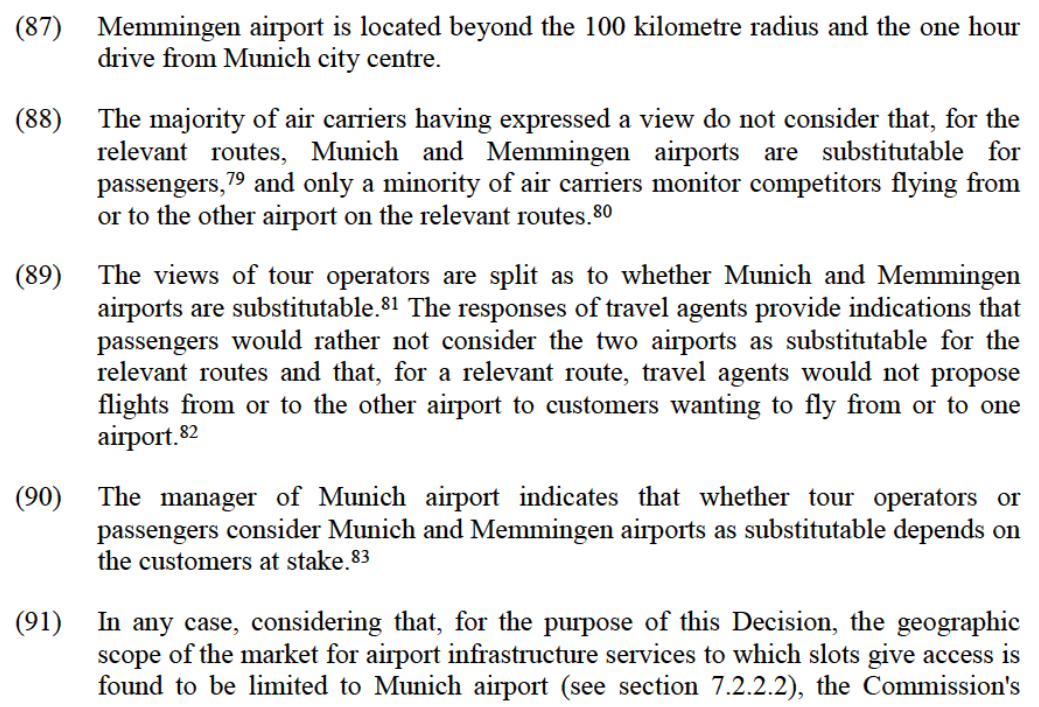
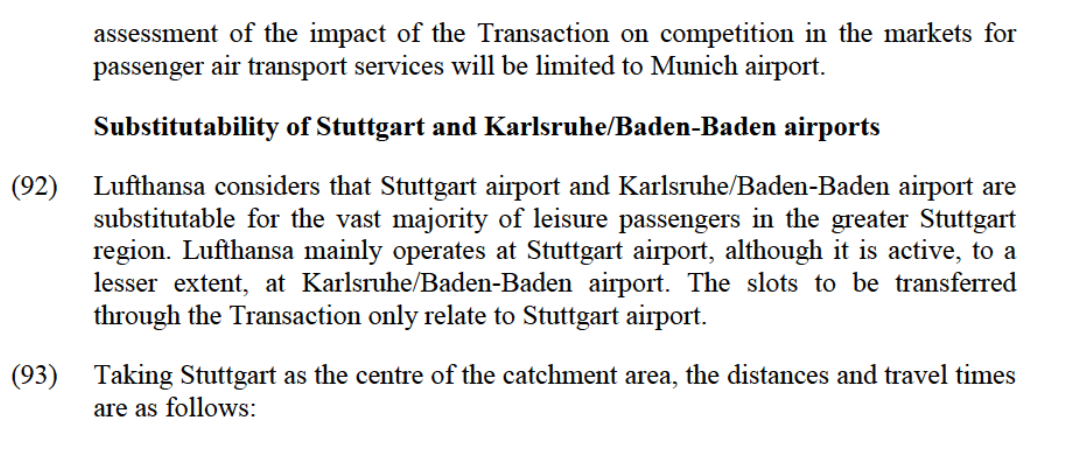

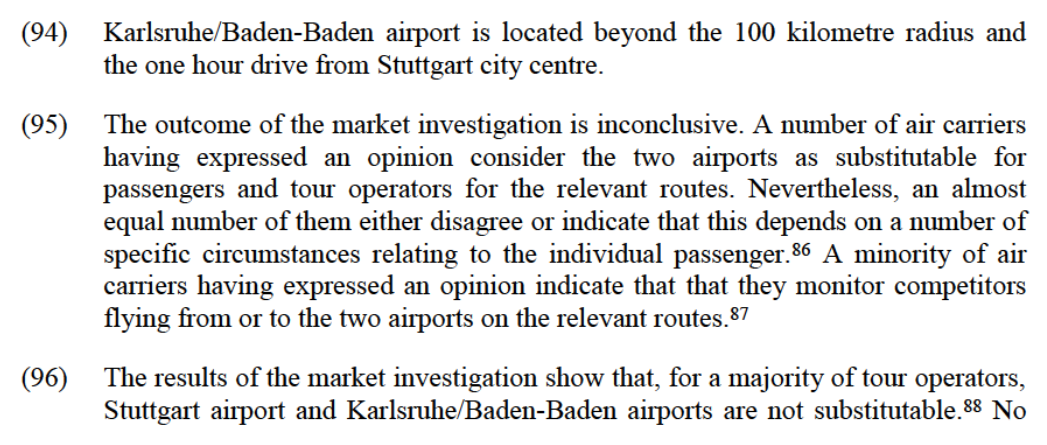
travel agent having responded to the market investigation considers that the two airports are substitutable.89 In this context, no travel agent would propose flights from or to Karlsruhe/Baden-Baden airport to passengers wanting to fly from or to Stuttgart airport (and vice versa).90
(97) Finally, the manager of Stuttgart airport states that passengers and tour operators barely consider Stuttgart airport and Karlsruhe/Baden-Baden airports as substitutable, and their catchment areas overlap only to a small extent, due to geographic and infrastructure reasons.91
(98) In any case, considering that, for the purpose of this Decision, the geographic scope of the market for airport infrastructure services to which slots give access is found to be limited to Stuttgart airport (see section 7.2.2.2), the Commission's assessment of the impact of the Transaction on competition in the markets for passenger air transport services will be limited to Stuttgart airport.
Substitutability of Zurich and Basel airports
(99) According to Lufthansa, the Northern Switzerland catchment area comprises at least Zurich airport and Basel airport. Lufthansa operates from both Zurich and Basel airports, while the slots to be transferred through the Transaction relate to Zurich airport only.
(100) In prior decisions, the Commission assessed routes from or to Zurich and Basel airports separately.92
(101) Taking Zurich as the centre of the catchment area the distances and travel times are as follows:
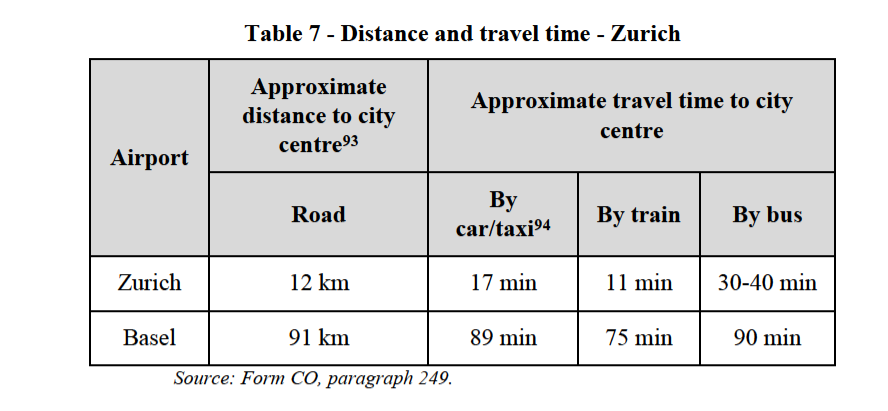
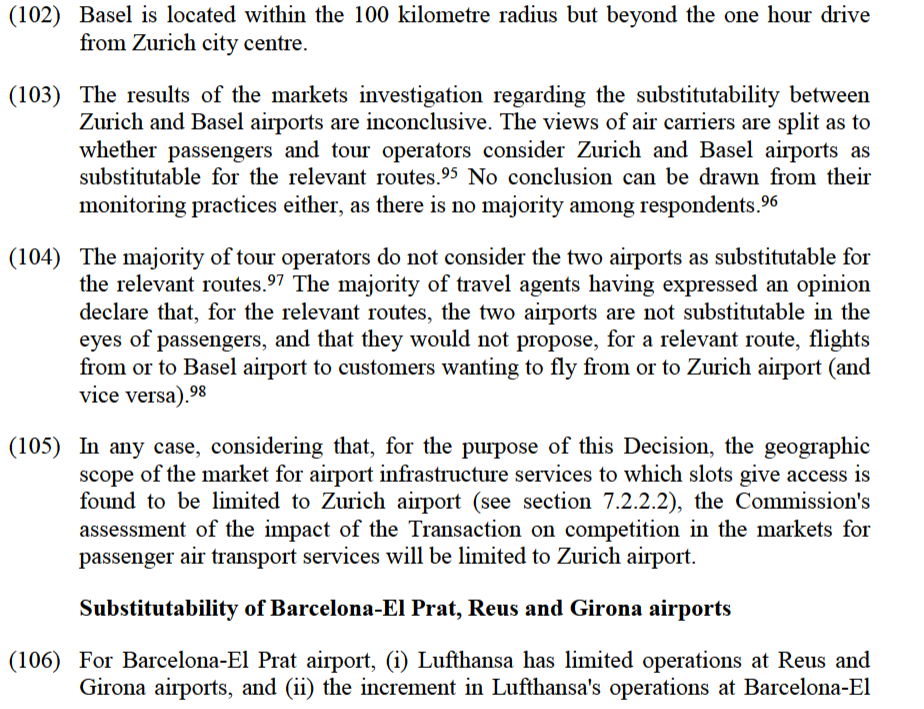
Prat airport brought about by the Transaction is de minimis, as explained in section 8.2.4.7.
(107) Therefore, the question of whether Barcelona-El Prat, Reus and Girona airports belong to the same geographic markets for passenger air transport can be left open, as the Transaction would not raise serious doubts as to its compatibility with the internal market under either plausible market definition (see section 8.2.4.7).
Substitutability of Venice and Treviso airports
(108) For Venice airport, (i) Lufthansa has no operations at Treviso airport, and (ii) the increment in Lufthansa's operations at Venice airport brought about by the Transaction is de minimis, as explained in section 8.2.4.7.
(109) Therefore, the question of whether Venice and Treviso airports belong to the same geographic markets for passenger air transport can be left open, as the Transaction would not raise serious doubts as to its compatibility with the internal market under either plausible market definition (see section 8.2.4.7).
Conclusion
(110) For the purpose of this Decision, the question of whether the geographic scope of the markets for passenger air transport services from or to a relevant airport is limited to an airport or encompasses airports in the same catchment area can be left open for Berlin, Barcelona and Venice airports, as the Transaction would not raise serious doubts as to its compatibility with the internal market under either plausible market definition (see section 8.2.4).
(111) For the purpose of this Decision, for Duesseldorf, Munich, Stuttgart and Zurich airports, considering that the geographic scope of the market for airport infrastructure services to which slots give access is limited to the airport, the Commission will analyse the effects of the Transaction on the markets for passenger air transport services from or to each of these airports.
7.2.2.2. Airport infrastructure services
(112) For the purpose of providing passenger air transport services at congested airports, airlines have to source infrastructure services at those airports. As indicated in section 7.1, at congested airports, infrastructure capacity is managed through the allocation of slots, which enable air carriers to fly to and from the airports. Slots are therefore defined, from the point of view of airports, as "a planning tool for rationing capacity at airports where demand for air travel exceeds the available runway and terminal capacity."99 From the point of view of airlines, the granting of a slot at an airport means that the airline may use the entire range of infrastructure necessary for the operation of a flight at a given time (runway, taxiway, stands and, for passenger flights, terminal infrastructure). This in turn enables the air carriers to provide passenger air transport services to and from that airport.
(113) As a consequence, through the transfer of Air Berlin's slots via LGW, Lufthansa obtains a right to access to a higher share of airport infrastructure capacity. The Transaction therefore has an impact on (the demand-side of) the markets for airport infrastructure services at the relevant airports and further on the markets for passenger air transport to and from those airports.
(a) Product market
(114) The Commission has, in its prior decision practice, delineated a product market for the provision of airport infrastructure services to airlines, which includes the development, maintenance, use and provision of the runway facilities, taxiways and other airport infrastructure.100 The Commission has considered sub-dividing the market for airport infrastructure services on the basis of airline customers (i.e. charter operators, scheduled full service carriers and scheduled low cost carriers) and on the basis of the type of flights (i.e. short haul and long haul).101
(115) For the reasons set out above in section 7.1.1, the Commission considers that slots are an essential input to enable air carriers to get access to airport infrastructure. As such, via slot holdings, air carriers are present on the demand side of the market for airport infrastructure services.
(116) Considering that the effects of the Transaction relate only to the reinforcement of Lufthansa's portfolio of slots and that the latter give access to all infrastructure services necessary to operate at the airport, the Commission considers that, for the purpose of this Decision, it is not necessary to further distinguish within the market for airport infrastructure services.
(b) Geographic market
(117) The Commission has, in its prior decision practice, defined the geographic scope of the market for airport infrastructure services as the catchment area of individual airports.
(118) The Commission has also considered additional criteria relevant for assessing airport substitutability in relation to the market for airport infrastructure services, while acknowledging that the airlines' choice of airports ultimately depends on passengers' demand. In addition to the catchment area of a particular airport, the Commission has notably analysed the costs of operating from a particular airport, capacity constraints for slots and facilities, passenger volumes or the positioning of the airport (e.g. a niche airport serving high yield time-sensitive passengers or an airport serving mainly leisure, less time-sensitive passengers).102
Overview of the relevant airports
(119) As indicated in section 7.2.2.1, the slots to be transferred through the Transaction relate to 19 airports, out of which 7 raise the issue of substitutability with other airports.
Substitutability of Berlin Tegel and Berlin Schoenefeld airports
(120) The question of the catchment area of Berlin Tegel and Berlin Schoenefeld airports is addressed in section 7.2.2.1.
(121) In terms of congestion, the two airports have limited slot availability at peak times.103 In addition, the two airports are large airports with more than one terminal, used in 2016 by over 21 million passengers for Berlin Tegel airport and approximately 12 million passengers for Berlin Schoenefeld airport.
(122) Nevertheless, Berlin Tegel airport appears more congested than Berlin Schoenefeld airport during peak periods and for longer periods throughout the day.104 The single airport manager of the two Berlin airports notes that the two airports have different particularities, Berlin Schoenefeld being a more low cost airport than Berlin Tegel, and Berlin Tegel being more used for business traffic and long-haul destinations.105
(123) In any case, for the purpose of this Decision, the question of whether Berlin Tegel and Berlin Schoenefeld airports belong to the same geographic market for airport infrastructure services can be left open, as the Transaction would not raise serious doubts as to its compatibility with the internal market under either plausible market definition (see section 8.2.4.5).
Substitutability of Duesseldorf, Cologne-Bonn, Dortmund, and Weeze airports
(124) The question of the catchment area of Duesseldorf, Cologne-Bonn, Dortmund, and Weeze airports is addressed in section 7.2.2.1.
(125) In terms of congestion, Duesseldorf airport presents very different features from the other three airports. It is coordinated (Level 3)106 during summer and winter, while Cologne-Bonn is schedules facilitated107 (Level 2).108 Dortmund and Weeze are neither coordinated nor schedules facilitated. As acknowledged by Lufthansa, potential entrants face different barriers to entry at Duesseldorf airport compared to the three other airports of the Rhine-Ruhr area.109
(126) In terms of size, Duesseldorf airport is, with 24 million passengers in 2016,110 larger than Cologne-Bonn (12 million passengers),111 Dortmund and Weeze (2 million passengers each).112 Duesseldorf airport has three terminals, Cologne-Bonn two, Dortmund and Weeze one.
(127) The airports have different positionings and marketing strategies vis-à-vis passenger traffic, which are reflected by the ranking of the airlines present at the airports and the destinations they serve. In 2016, the main customers of Duesseldorf airport services were Air Berlin, the Lufthansa Group (Eurowings/Germanwings, Lufthansa and SunExpress) as well as Condor. The 72 airlines operating at Duesseldorf airport served 52 countries and 204 destinations, showing that air carriers use Duesseldorf airport for connections and long-haul traffic, as well as for the supply of wholesale seats to tour operators.113 By contrast, Cologne-Bonn airport is mainly oriented towards low-cost carriers, with the Lufthansa Group (Eurowings) and Ryanair being the first two air carriers at the airport. Eurowings started operating long-haul routes only in 2016.114 As to Dortmund and Weeze, they almost exclusively depend on low-cost carriers, in particular Wizz Air for Dortmund115 and Ryanair for Weeze.116
(128) The above elements demonstrate that the demand from airlines is consistently higher at Duesseldorf airport than in the other airports and that the services sourced from Duesseldorf airport are more comprehensive than those provided by other airports. The market investigation has provided indications that demand of airport services by airlines is relatively price-inelastic.117 This is particularly true at capacity constrained hubs like Dusseldorf airport, for which air carriers would not easily switch their operations to other airports due to the need to protect slots and to recoup their investments.118 As a consequence, most air carriers present at Duesseldorf airport would unlikely switch to other airports if Duesseldorf airport were to increase its airport charges by 5-10% on a permanent basis.
(129) Lufthansa itself does not seem to consider Cologne-Bonn airport as an adequate substitute for Duesseldorf airport, since […].119
(130) Considering that (i) only Duesseldorf airport is a coordinated airport, and (ii) Duesseldorf airport has a different positioning and market strategy (serving in particular full service carriers offering intercontinental flights), the Commission concludes that, for the purpose of this Decision, the geographic scope of the market for the provision of airport infrastructure services to airlines is limited to Duesseldorf airport.
Substitutability of Munich and Memmingen airports
(131) The question of the catchment area of Munich and Memmingen airports is addressed in section 7.2.2.1.
(132) Munich airport is a coordinated (Level 3) airport during summer and winter, while Memmingen airport is neither coordinated nor schedules facilitated. According to Lufthansa, slot utilisation at Munich airport is 72%, whereas Memmingen airport is not subject to any slot constraints.120 The number of passengers at Munich airport reached 42 million in 2016,121 compared to 1 million for Memmingen airport in 2016.122
(133) Munich airport is a European hub, serving 100 airlines, 73 countries and 257 destinations and accounting for the highest share of business travellers in Germany in 2016,123 while Memmingen airport is a regional airport targeting low-cost or destination air carriers (Wizz Air, Ryanair, Corendon or Fly Egypt).
(134) Considering that (i) only Munich airport is a coordinated airport, and (ii) Munich airport has a different positioning and market strategy (serving in particular full service carriers offering intercontinental flights), the Commission concludes that, for the purpose of this Decision, the geographic scope of the market for the provision of airport infrastructure services to airlines is limited to Munich airport.
Substitutability of Stuttgart and Karlsruhe/Baden-Baden airports
(135) The question of the catchment area of Stuttgart and Karlsruhe/Baden-Baden airports is addressed in section 7.2.2.1.
(136) Stuttgart airport is a coordinated (Level 3) airport during summer and winter, while Karlsruhe/Baden-Baden airport is neither coordinated nor schedules facilitated. Lufthansa notes that there are no slot constraints at Karlsruhe/Baden-Baden airport and that all slot requests were accommodated in 2017.124 The number of passengers at Stuttgart airport reached 11 million in 2016,125 compared to 1 million for Karlsruhe/Baden-Baden airport in 2016.126
(137) Stuttgart airport serves 55 airlines and 100 destinations,127 while Karlsruhe/Baden-Baden markets itself as a "regional airport of short distances", targeting leisure or low cost air carriers.128
(138) Considering that (i) only Stuttgart airport is a coordinated airport, and (ii) Stuttgart airport has a different positioning and market strategy (serving in particular full service carriers), the Commission concludes that, for the purpose of this Decision, the geographic scope of the market for the provision of airport infrastructure services to airlines is limited to Stuttgart airport.
Substitutability of Zurich and Basel airports
(139) The question of the catchment area of Zurich and Basel airports is addressed in section 7.2.2.1.
(140) Zurich airport is a coordinated (Level 3) airport during summer and winter, while Basel airport is neither coordinated nor schedules facilitated. As indicated by Lufthansa, there are no slot constraints at Basel airport, while there are at Zurich airport.129 The number of passengers at Zunich airport reached 28 million in 2016,130 compared to 7 million for Basel airport in 2016.131
(141) Zurich airport serves 68 airlines to 178 airports, including 53 intercontinental destinations representing 23% of the total number of passengers,132 while 25 airlines operate at Basel airport to 70-100 short-haul destinations.133
(142) Considering that (i) only Zurich airport is a coordinated airport, and (ii) Zurich airport has a different positioning and market strategy (in particular, it has a more developed intercontinental network), the Commission concludes that, for the purpose of this Decision, the geographic scope of the market for the provision of airport infrastructure services to airlines is limited to Zurich airport.
Substitutability of Barcelona-El Prat, Reus and Girona airports
(143) As mentioned in section 7.2.2.1, the question of airport substitutability does not need to be assessed in detail for Barcelona-El Prat airport, as it would not change materially the assessment of the effects of the Transaction on Lufthansa's slot holding at the airports (see section 8.2.4.7).
Substitutability of Venice and Treviso airports
(144) As mentioned in section 7.2.2.1, the question of airport substitutability does not need to be assessed in detail for Venice airport, as it would not change materially the assessment of the effects of the Transaction on Lufthansa's slot holding at the airports (see section 8.2.4.7).
Conclusion
(145) For the purpose of this Decision, the question of whether the geographic scope of the market for airport infrastructure services is limited to the airport or encompasses airports in the same catchment area can be left open for Berlin Tegel, Barcelona-El Prat and Venice airports, as the Transaction would not raise serious doubts as to its compatibility with the internal market under either plausible market definition (see section 8.2.4).
(146) For the purpose of this Decision, for Duesseldorf, Munich, Stuttgart and Zurich airports, the Commission considers that, in view of the evidence available to it, the market for airport infrastructure services is limited to the airport.
7.2.2.3. Conclusion
(147) In light of the above, for the purpose of this Decision, the Commission will leave the question of the geographic market definitions for Berlin Tegel, Barcelona-El Prat and Venice airports open.
(148) Considering that Lufthansa's slots and the slots to be transferred through the Transaction overlap at Berlin Tegel airport only, the Commission's competitive assessment will be conducted under the assumption that Berlin Tegel airport is a market distinct from Berlin Schoenefeld airport.
(149) Considering that Lufthansa's slots and the slots to be transferred through the Transaction overlap at Barcelona-El Prat airport only, the Commission's competitive assessment will be conducted under the assumption that Barcelona-El Prat airport is a market distinct from Reus and Girona airports.
(150) Considering that Lufthansa's slots and the slots to be transferred through the Transaction overlap at Venice airport only, the Commission's competitive assessment will be conducted under the assumption that Venice airport is a market distinct from Treviso airport.
(151) In addition, in light of the above, for the purpose of this Decision, the Commission will assess whether the Transaction has anticompetitive effects on the markets for passenger air transport from or to Duesseldorf, Munich, Stuttgart and Zurich airports, under the geographic market definition corresponding to a single airport.
(152) In order to assess the effects of the Transaction on the markets for passenger air transport from or to airports, the Commission will take account of the reinforcement of Lufthansa's slot holding at those airports, hence of the reinforcement of its position on the demand-side of the market for airport infrastructure services.
7.3. Relevant situation absent the Transaction
(153) Pursuant to paragraph 9 of the Horizontal Merger Guidelines,134 "[i]n assessing the competitive effects of a merger, the Commission compares the competitive conditions that would result from the notified merger with the conditions that would have prevailed without the merger. In most cases the competitive conditions existing at the time of the merger constitute the relevant comparison for evaluating the effects of a merger. However, in some circumstances, the Commission may take into account future changes to the market that can reasonably be predicted."
(154) Lufthansa underlines that LGW's operations were heavily dependent on Air Berlin's hub operations (in particular long-haul traffic), which Air Berlin has already discontinued irrespective of the Transaction.135 Therefore, LGW's operations prior to Air Berlin's insolvency proceedings were unsustainable and cannot be viewed as the relevant situation absent the Transaction.136
(155) The Commission acknowledges that Air Berlin's on-going insolvency proceedings will most likely lead Air Berlin to be eventually wound up. In the light of the fact that Air Berlin has already exited the passenger air transport markets at the relevant airports (see section 6), the Commission considers that the most likely scenario absent the Transaction is that Air Berlin no longer operates from these airports and that the slots that it currently holds (including the LGW slots and the surplus slots) would be made available to third parties.
(156) More specifically, absent the Transaction, Air Berlin's slots to be transferred to Lufthansa via LGW (the LGW slots and the surplus slots) would either be made available to other third parties than Lufthansa through the sale of all or parts of an air carrier during the insolvency proceedings, or, in the absence of acquirers, fall back to the slot pools and be subsequently reallocated by the relevant slot coordinators (see section 7.1.2).
(157) Based on the information received by the Commission during its market investigation about the credible bids submitted for the air operations of LGW or Air Berlin (excluding NIKI), the Commission considers that, for the purpose of this Decision, the LGW slots and the surplus slots would likely fall back to the slot pools in the situation absent the Transaction.137
(158) These scenarios impact the situation absent the Transaction in two respects. First, the number of slots that Lufthansa would obtain is impacted, as Lufthansa would likely obtain slots in the second scenario through the reallocation process of slots returned to the pool, but not in the first scenario. This, in turn, has an impact on the difference between the number of slots obtained through the Transaction and the number of slots that Lufthansa would have obtained in the situation absent the Transaction (i.e. the "net increment" brought about by the Transaction, see section 8.2.3.1).
(159) Second, the question of the distribution of the LGW slots and of the surplus slots absent the Transaction has an impact on the slot holding of Lufthansa's competitors at the relevant airports (as they would also obtain slots through a possible reallocation process), hence on the competitive constraint they would be able to exert on Lufthansa absent the Transaction.
8. COMPETITIVE ASSESSMENT
(160) According to Lufthansa's internal documents, one of the rationales for entering into a purchase agreement with Air Berlin was […]. Competitors, especially low cost carriers, could have taken such opportunity to grow and could have expanded their market position in the DACH region (Germany, Austria and Switzerland). This rationale has supported the decision by Lufthansa's Board to initiate the purchase of Air Berlin's assets138 and is illustrated by the following table:139
[…]
Source: Form CO, Section 5.4 Documents, […].
(161) In particular, Lufthansa intends to use LGW as […].140
(162) In this context, the Commission will assess whether the Transaction is likely to lead to the creation or strengthening of a dominant position in slot holding having anti-competitive effects on passenger air transport at the airports where, as a result of the Transaction, Lufthansa will obtain additional slots.
8.1. Legal framework
(163) According to paragraph 36 of the Horizontal Merger Guidelines,141 "some proposed mergers would, if allowed to proceed, significantly impede effective competition by leaving the merged firm in a position where it would have the ability and incentive to make the expansion of smaller firms and potential competitors more difficult or otherwise restrict the ability of rival firms to compete. In such a case, competitors may not, either individually or in the aggregate, be in a position to constrain the merged entity to such a degree that it would not increase prices or take other actions detrimental to competition. For instance, the merged entity may have such a degree of control, or influence over, the supply of inputs or distribution possibilities that expansion or entry by rival firms may be more costly."
(164) Accordingly, the Commission will first assess whether the Transaction, by reinforcing Lufthansa's slot holding at a number of airports and granting it broader access to their infrastructure, gives Lufthansa the ability and incentive to prevent other air carriers from getting access to airports' infrastructure and therefore to the markets for the provision of passenger air transport services from those airports, preventing or reducing competition on those markets (sections 8.2 and 8.3). The Commission will then analyse the overall effects of Lufthansa's dominant slot holding position, if any, on the ability of Lufthansa's rivals to compete at the relevant airports (section 8.4).
8.2. Ability of Lufthansa to foreclose access to the markets for the provision of passenger air transport services
8.2.1. Link between a dominant slot holding position and the ability to foreclose access
(165) To be able to provide passenger air transport, an air carrier needs access to airport infrastructure. At congested airports, an air carrier must thus hold slots to operate routes from or to those airports.
(166) Lack of access to slots is therefore a barrier to an air carrier's ability to compete for passengers between an airport and the destinations served from the airport. Lufthansa itself considers that slot constraints are relevant barriers to entry in the airline industry.142 An airline's slot holding at an airport provides a measure of its ability to compete on the passenger air transport market to or from that airport.
(167) In the present case, the market investigation unambiguously confirmed that there are advantages in the holding of a large portfolio of slots at an airport.143 An airport manager notably underlined that "[t]he more capacity that an airline has at an airport gives it more market power to compete with other airlines", while another noted: "For airlines a high market shares gives following advantages: High market presence and market penetration; Efficient operations at the airports; Operational flexibility through swapping slots within their own operation; Higher negotiating power with the airports and other service providers."144 Air carriers and tour operators also point out the economies of scale, greater flexibility to react to changes in demand as well as the maximisation of passenger load factors granted by a large slot portfolio, e.g.: "[w]ith a large slot portfolio an airline can offer a hub and spoke network connecting SH and LH flights; or a broad p2p route network with an efficient cost structure and optimised to changing customer demand"145 or "may be the airline can gain better prices for handling from the airport authorities and it is easier/cheaper for their marketing activities as the airline can concentrate on a certain (limited) area."146
(168) In addition, the market investigation demonstrated the link between the holding of a large portfolio of slots at an airport and the ability to influence access of competitors to the passenger air transport markets at the airport. An air carrier referred to the ability of large slot holders to operate the highest number of, and most demanded flights at congested airports: "Slots are used to allocate the right to operate a flight at a certain time of a day to an airline. Assuming that the number of available slots at an airport is limited, the airline holding the largest slot portfolio at that airport will have the chance to operate the most flights at that airport. Furthermore, this airline will have the highest flexibility to build an ideal schedule. The airline could offer flight times that matches perfectly the demand of the market,"147 while another mentioned more directly the possibility to block entry or expansion: "this massive slot portfolio will prevent other competitors from entering new routes or grow existing offers."148
(169) Air carriers holding a large slot portfolio may adopt practices aimed at preventing entry or expansion by other carriers at airports, such as predatory pricing, "slot hoarding", "slot babysitting",149 or use of their "slot shuffling power"150 to engage into exclusionary conduct.
(170) A number of airport managers confirmed the link between the breadth of a slot portfolio and the ability to prevent access of other airlines to airport infrastructure services, in particular for competitors wishing to base an aircraft and therefore, requiring the slots necessary to build sustainable rotations. As examples, two airport managers stated the following: "The bigger the slot portfolio, the bigger is the flexibility, i.e. in getting the best slot: (i) For high yield destination; (ii) To secure connectivity at their hub; (iii) To be able to get the best possible Slot at Destination by the possibility to adjust the departure time from their base; (iv) To keep your competitors out" and "Large slot portfolios and therefore high market shares at the airport leads to more market power and makes it easier to keep out competitors."151
(171) An air carrier indicated that a large portfolio of slots reinforces the bargaining power of airlines vis-à-vis airports, which would be less open to new entrants: "Controlling a large slot portfolio and the operations associated therewith also enables airlines to exercise significant pressure on the respective airport. LH Group has for instance used its market share at FRA to criticize FRA’s openness to low cost carrier and has criticized FRA for trying to become more independent of LH Group. In addition it has announced that it will grow at other hubs. This can be understood as LH Group’s message to airports to minimize their incentives to new airlines as they would otherwise need to fear upsetting their main customer. Such behavior clearly limits the commercial freedom of the airports, potential new airline entrants and thus ultimately the choice of customers – individual passengers and tour operators alike."152
(172) Another air carrier notes that "a dominant airline has numerous possibilities to use its influence at an airport in order to foreclose the airport for competitors", notably using its negotiating power "this influence to develop the airport’s infrastructure even more in its own favour."153
(173) An air carrier also elaborates on Lufthansa's practice of cross-subsidisation of routes: "LH already cross-subsidizes routes that are subject to competition. (…) The low prices on routes subject to competition can be offset by high revenues on routes subject to a LH-monopoly, especially regarding the German domestic market. This unfair advantage over smaller competitors leads to a high risk of squeeze out on the routes concerned, thus leading to a further weakening of fair competition."154
(174) Furthermore, under the current regulatory framework, the current system of slot allocation does not have a sufficiently strong deterrent effect against the anticompetitive use of slots.155 As noted by an air carrier, the use-it-or-lose-it rule156 is easier to comply with by large slot portfolio holders: "[A]irlines that hold a large slot portfolio can better ensure that all slots are at least utilized to 80% by shifting departures and origins to slots running a risk to be underutilized. This practice is easier if an airline uses the same airport for many destinations and with a larger slot portfolio. If an airline only controls one weekly slot at an airport and wants to offer a weekly service to that airport it will fully utilize that slot. However, if an airline controls five slots it only requires four services to ensure the 80% utilization rate required to trigger the Slot Regulation's grandfathering rights. Airlines controlling a large slot portfolio can thus reserve a 20% contingency pool that allows reacting quickly to increased demand or changes in the demand from one destination to another."157
(175) Finally, Lufthansa's internal documents indicate that […].
(176) [Lufthansa's slot holding strategy].158 […].159 […].
(177) [Example at Frankfurt airport].160
(178) [Example at Munich airport].161[…].162
(179) [Example at Zurich airport].163
(180) [Lufthansa's commercial strategy].164
(181) [Example at Duesseldorf airport].165 […].166
8.2.2. Conditions for the ability for foreclose access
(182) For Lufthansa to be able to foreclose its competitors post-Transaction, the following conditions must be fulfilled: (i) the slots that Lufthansa would hold post-Transaction represents a significant share of the airport capacity, in particular at peak times; (ii) the Transaction has a material impact on Lufthansa's slot holding at the airport, in particular at peak times; and (iii) Lufthansa's slot holding could negatively affect the overall availability of input for the passenger air transport markets from or to the relevant airport.
(183) This third criterion requires that (i) the airport at which Lufthansa would hold a large portfolio of slots does not have sufficient available capacity (i.e. its level of congestion is high); and (ii) the airports considered as substitutable by air carriers (if any, see section 7.2.2) do not have sufficient available capacity either.
(184) The Commission also considered whether rival firms would be likely to deploy effective and timely counter-strategies in case of foreclosure. In this case, the Commission notes that there are limited effective and timely counter-strategies that Lufthansa's competitors would be likely to deploy in case of foreclosure strategy by Lufthansa. There is no possibility for an air carrier to be less reliant on access to airport infrastructure and very limited possibility to sponsor the expansion of airport capacity or the opening of new airports.167
(185) In light of the above, the Commission will assess the ability of Lufthansa post-Transaction to foreclose access to the markets for the provision of passenger air transport at the relevant airports by taking account of the following three factors together: (i) the share of slots held by Lufthansa post-Transaction at the airport or at substitutable airports being high, in particular at peak times;168 (ii) the net increment in Lufthansa's slot holding brought about by the Transaction at the airport or at the substitutable airports being material, in particular at peak times; and (iii) the level of congestion at the airport or at the substitutable airports being high. Considering that Lufthansa's slot holdings and the levels of congestion of the relevant airports vary between the Summer and Winter IATA Seasons, the Commission will carry out separate assessments for each IATA Season.
(186) Before an airport-by-airport assessment of Lufthansa's ability to foreclose access to the markets for the provision of passenger air transport (section 8.2.4), the Commission will detail the methodologies for determining airport congestion, Lufthansa's slot holding post-Transaction and the increment brought about by the Transaction.
8.2.3. Methodologies
8.2.3.1. Slot holding and increment brought about by the Transaction
(187) A slot holding is defined as the ratio between the number of slots held by an air carrier (or the air carriers that are part of the same group) at an airport and the total available slots at that same airport (i.e. the airport capacity).
(188) Lufthansa has estimated its slot holding and Air Berlin's slot holding (including the LGW and surplus slots) at an airport on the basis of statistical data collected by the Online Coordination System and e-Airportslots.aero.169
(189) The Commission has checked the overall accuracy of the data submitted by Lufthansa against the information gathered from airport managers and slot coordinators during the market investigation.170
(190) The Commission has calculated two values for Lufthansa's slot holding post-Transaction: (i) its average slot holding during the opening hours of the airport, and (ii) its average slot holding during peak times.
(191) In order to adopt a conservative approach, the Commission has calculated Lufthansa's highest slot holding at any given hour band throughout the whole week (including any peak hour), which exceeds its average slot holding during peak times.
(192) The "gross increment" of Lufthansa's slot holding corresponds to the difference between Lufthansa's slot holding post-Transaction and Lufthansa's slot holding pre-Transaction. Lufthansa's slot holding post-Transaction takes account of (i) the slots to be transferred to Lufthansa through the Transaction, and (ii) the slots held by Air Berlin (including NIKI) that will be returned to the slot pools, which Lufthansa could obtain through the regular allocation process referred to in section 7.1.2.
(193) The "net increment" brought about by the Transaction corresponds to the difference between Lufthansa's slot holding post-Transaction and Lufthansa's slot holding in the situation absent the Transaction. Lufthansa's slot holding in the situation absent the Transaction takes account of the slots held by Air Berlin (including NIKI) to be returned to the slot pools, which Lufthansa could obtain through the regular allocation process referred to in section 7.1.2.171
(194) To assess the impact of the Transaction, one should consider Lufthansa's slot holding post-Transaction, as well as the net increment of Lufthansa's slot holding as a result of the Transaction.
8.2.3.2. Airport congestion
(195) The Commission used the qualification as a coordinated airport under the Slot Regulation or, for non-EU airports, as a Level 3 airport under the IATA Worldwide Slot Guidelines172 as a first proxy of the high congestion level of an airport. Indeed, such qualification means that, at these airports, the demand for airport infrastructure, notably slots, significantly exceeds the airport's capacity and the expansion of airport infrastructure to meet demand is not possible in the short term.
(196) For coordinated and Level 3 airports, the Commission has further calculated the actual congestion rate during the opening hours of an airport by dividing the number of slots allocated to all airlines at the airport in a week of the relevant IATA season by the total capacity of the airport in a week (in terms of slots) in the relevant IATA season. The congestion rate of the airport has also been calculated for each hour band by dividing the number of slots allocated to all airlines during the relevant hour band throughout the whole week by the total capacity of the airport during the same hour band throughout the whole week. An average congestion rate during the opening hours of less than 60% would not be prima facie problematic.
(197) The Commission has qualified as "peak times" the hour bands for which the congestion rate at a given airport is very high, and therefore very limited, or no, capacity for entry or expansion is left.
8.2.4. Airport-by-airport assessment
(198) Through the Transaction, Lufthansa would be transferred slots at 19 airports, either for one or both IATA Seasons, as described in paragraph 61. More precisely, Lufthansa would be transferred slots at (i) 16 airports for Summer 2018 IATA Season,173 and (ii) 18 airports for Winter 2017/2018 IATA Season.174 Lufthansa already operates at all these airports, and would thereby expand its portfolio of slots at these airports during the relevant IATA Season.
(199) Among the 16 airports at which Lufthansa would be transferred slots through the Transaction for Summer IATA Season, 12 are coordinated or Level 3 airports.175
(200) Among the 18 airports at which Lufthansa would be transferred slots through the Transaction for Winter IATA Season, 13 are coordinated or Level 3 airports.176
(201) Therefore, the Commission will assess Lufthansa's slot holding in Summer IATA Season at the 12 Level 3 airports177 and in Winter IATA Season at the 13 Level 3 airports.178
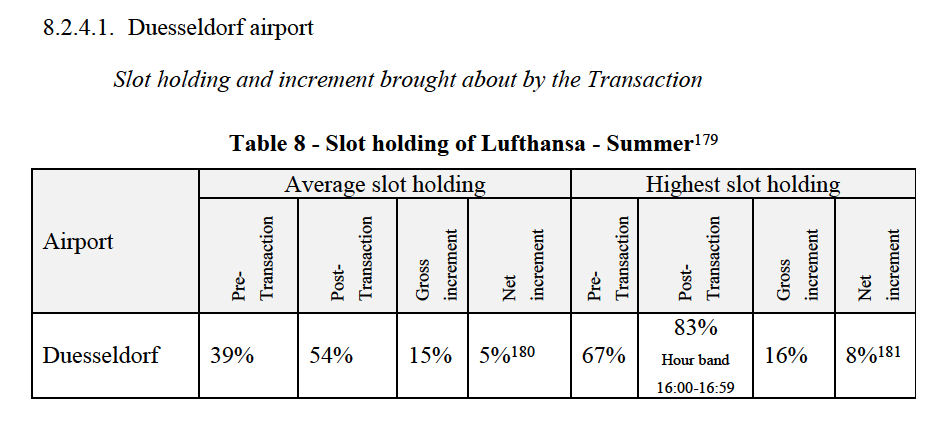
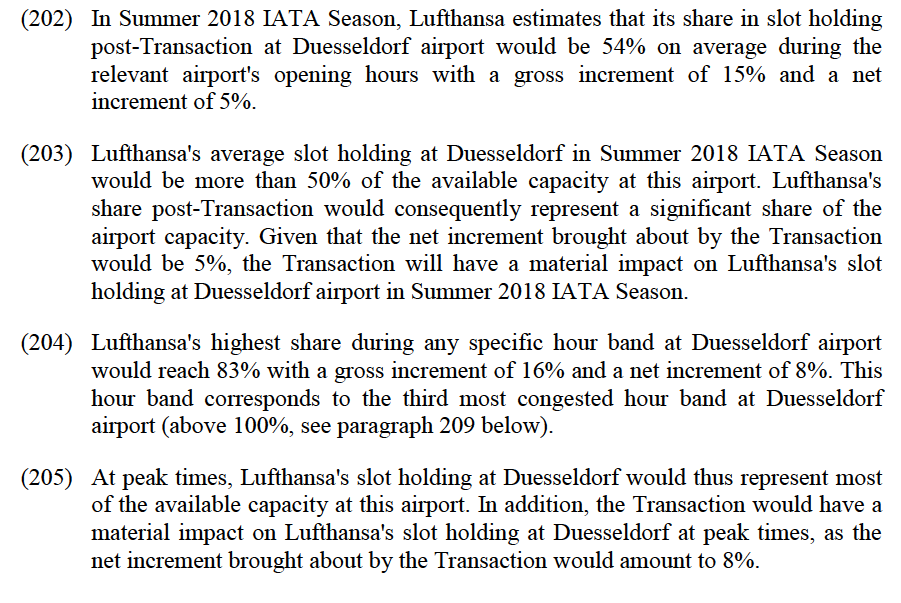
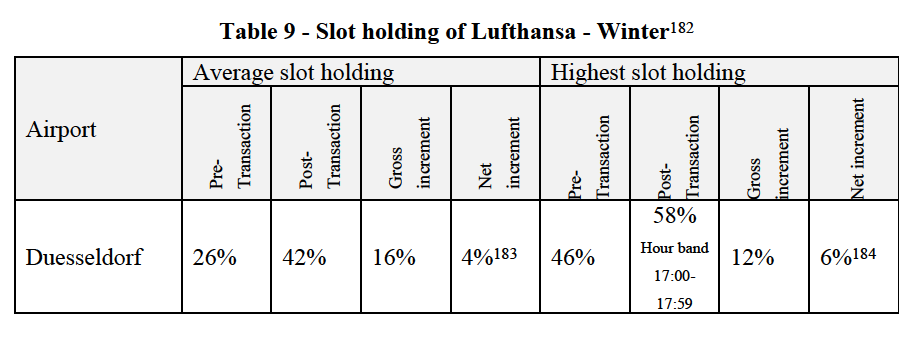
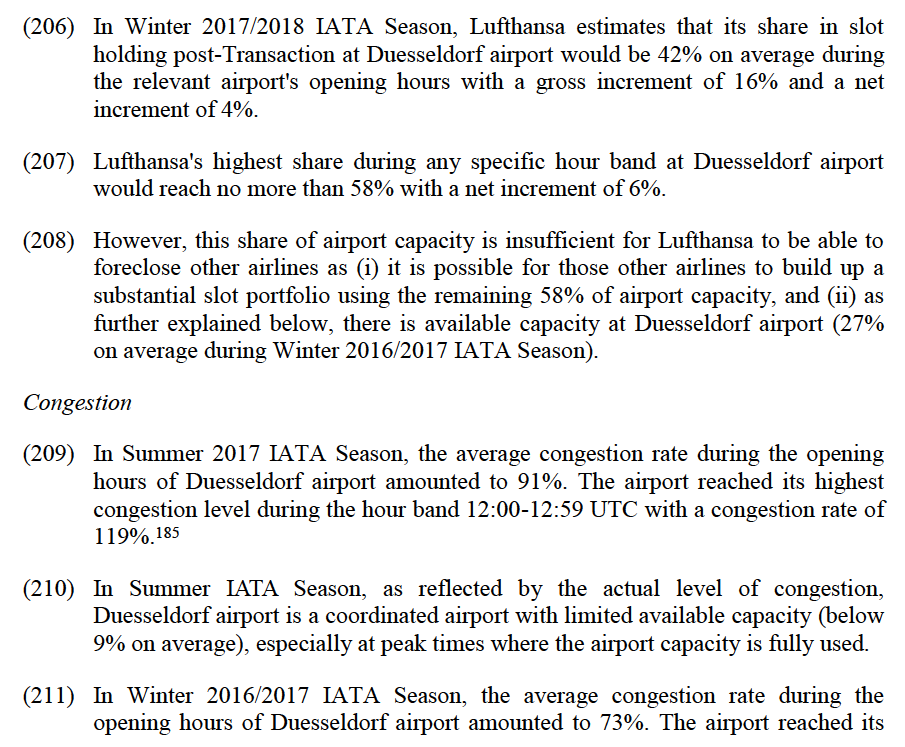
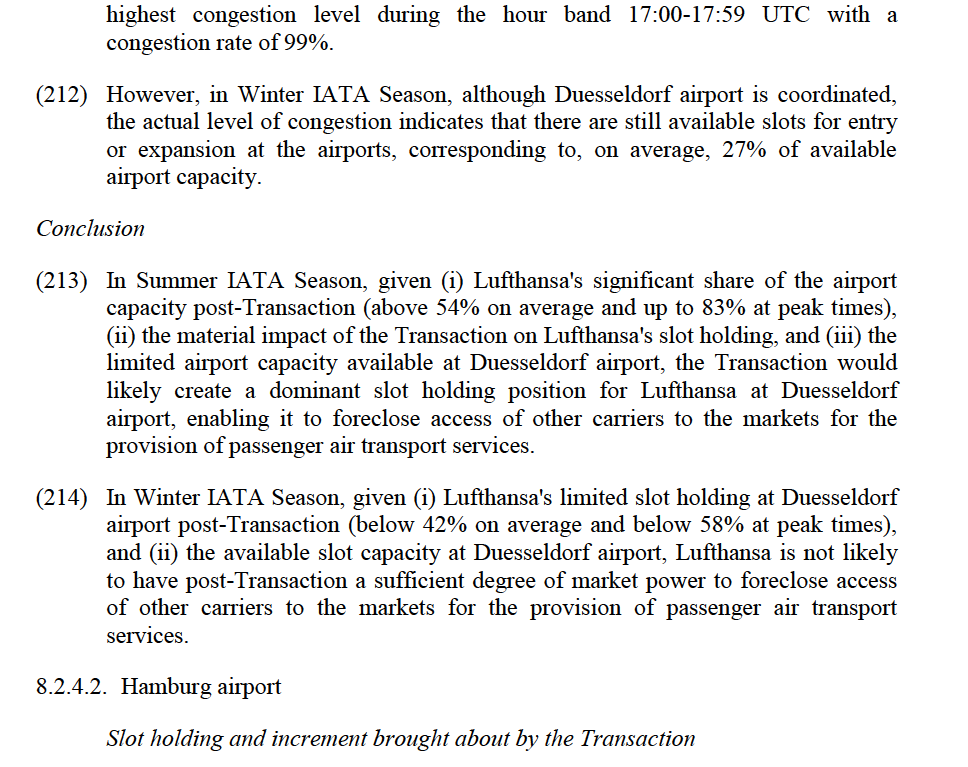
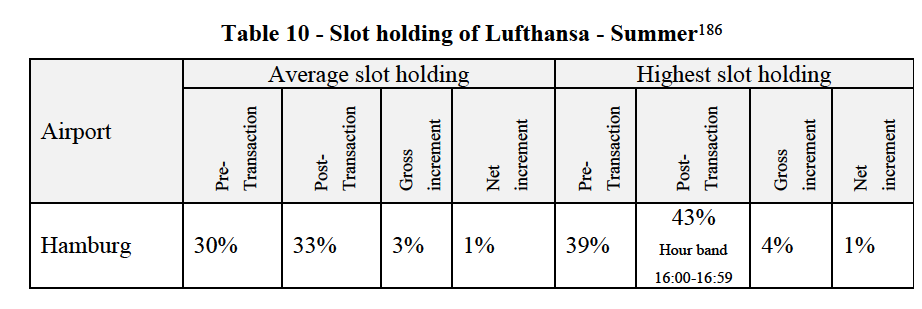


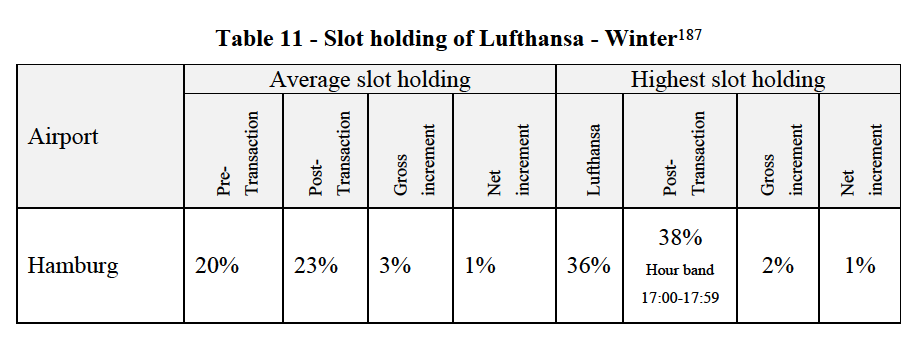
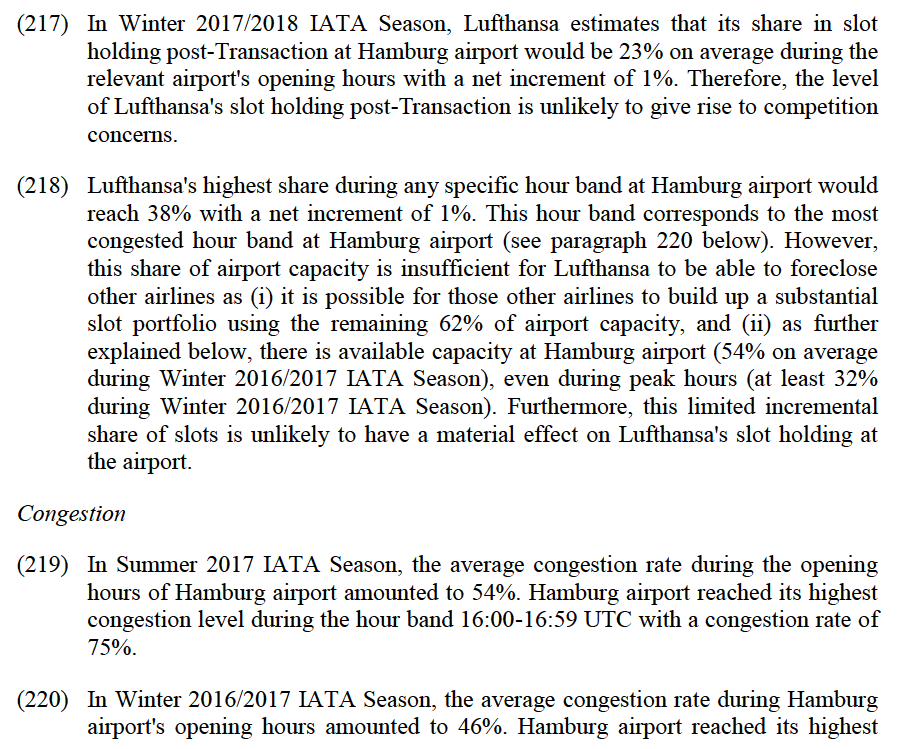
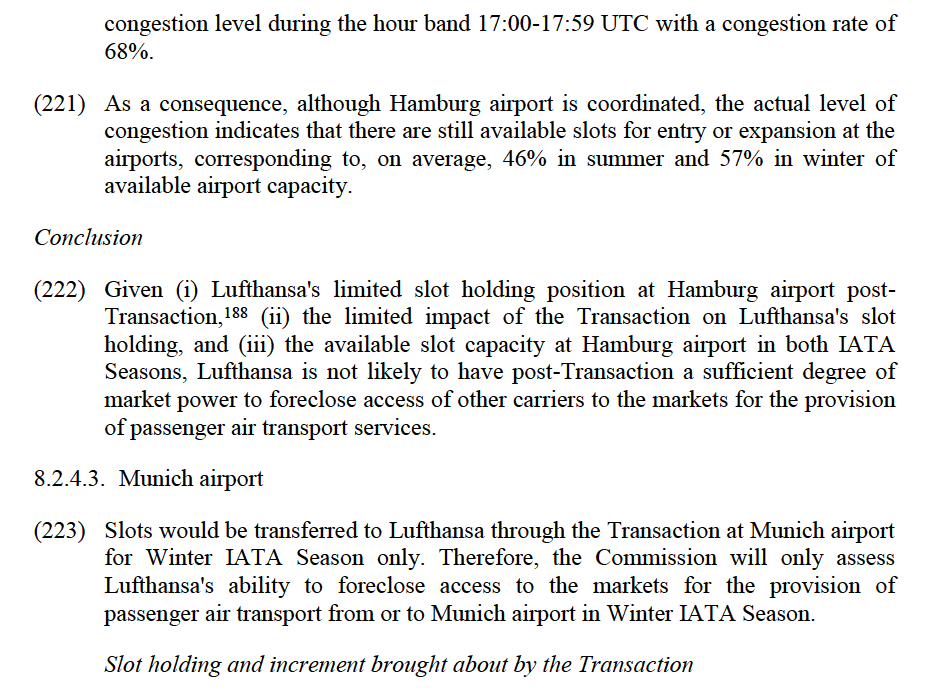
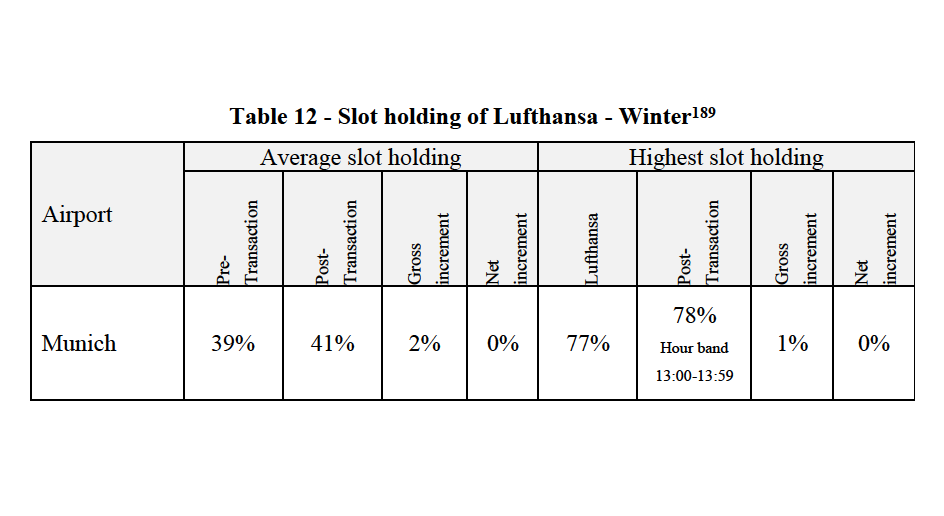

substantial slot portfolio using the remaining 59% of airport capacity, and (ii) as further explained below, there is available capacity at Munich airport (40% on average during Winter 2016/2017 IATA Season). Furthermore, this limited incremental share of slots is unlikely to have any material impact on Lufthansa's slot holding at Munich airport in view of Lufthansa's current slot portfolio, which accounts on average for 39% of the available capacity at this airport.
(225) Lufthansa's highest share during any specific hour band at Munich airport would reach no more than 78% with a net increment of 0%. This hour band corresponds to the most congested hour band at Munich airport (see paragraph 226 below). The Commission considers that this immaterial incremental share of slots is unlikely to have any material impact on Lufthansa's slot holding at Munich airport in view of Lufthansa's current slot portfolio, which accounts on average for 79% at most during any hour band in Winter IATA Season.
Congestion
(226) In Winter 2016/2017 IATA Season, the average congestion rate during the Munich airport's opening hours amounted to 60%. The Munich airport reached its highest congestion level during the hour band 13:00-13:59 UTC with a congestion rate of 93%.
(227) As a consequence, although the Munich airport is coordinated, the actual level of congestion indicates that there are still available slots for entry or expansion at the airports, corresponding to, on average, 40% in winter of available airport capacity.
Conclusion
(228) In Winter IATA Season, given (i) Lufthansa's limited slot holding position at Munich airport post-Transaction (no more than 41% on average), (ii) the limited impact of the Transaction on Lufthansa's slot holding (immaterial net increment), and (iii) the available slot capacity at Munich airport, the Transaction would not materially affect Lufthansa's degree of market power foreclose access of other carriers to the markets for the provision of passenger air transport services.
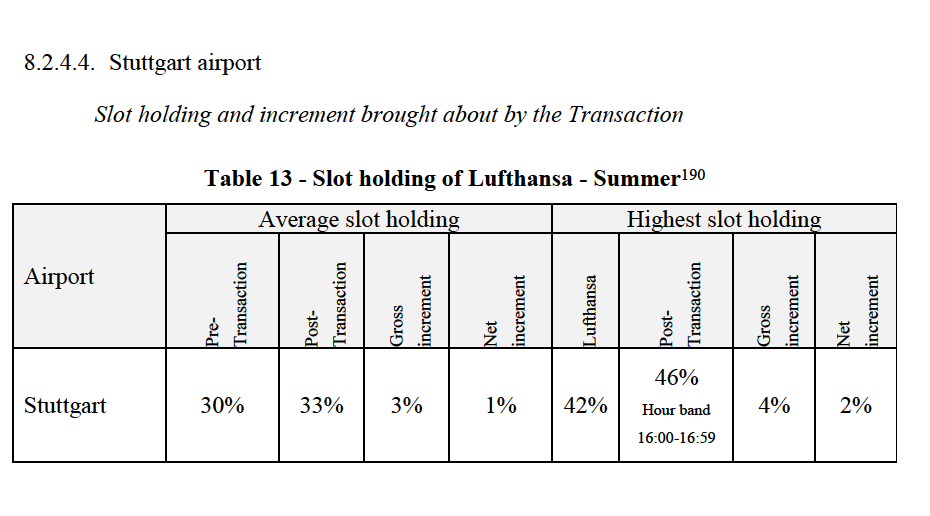
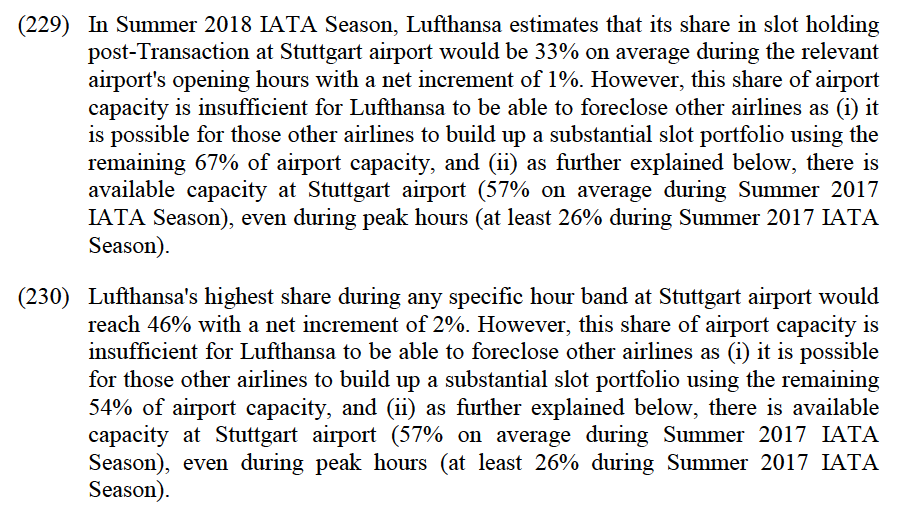
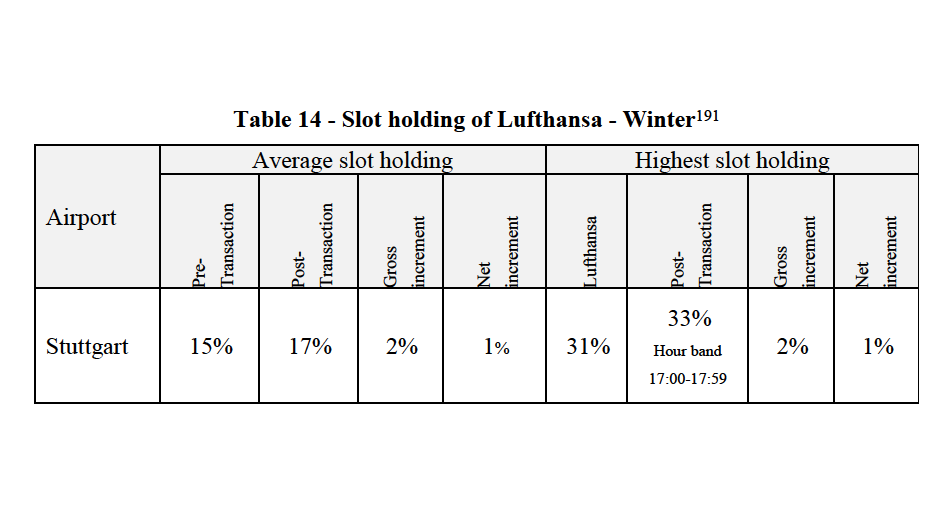
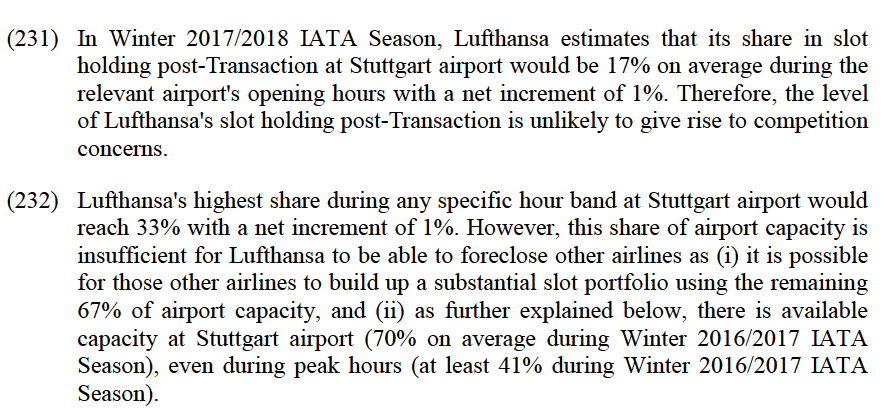
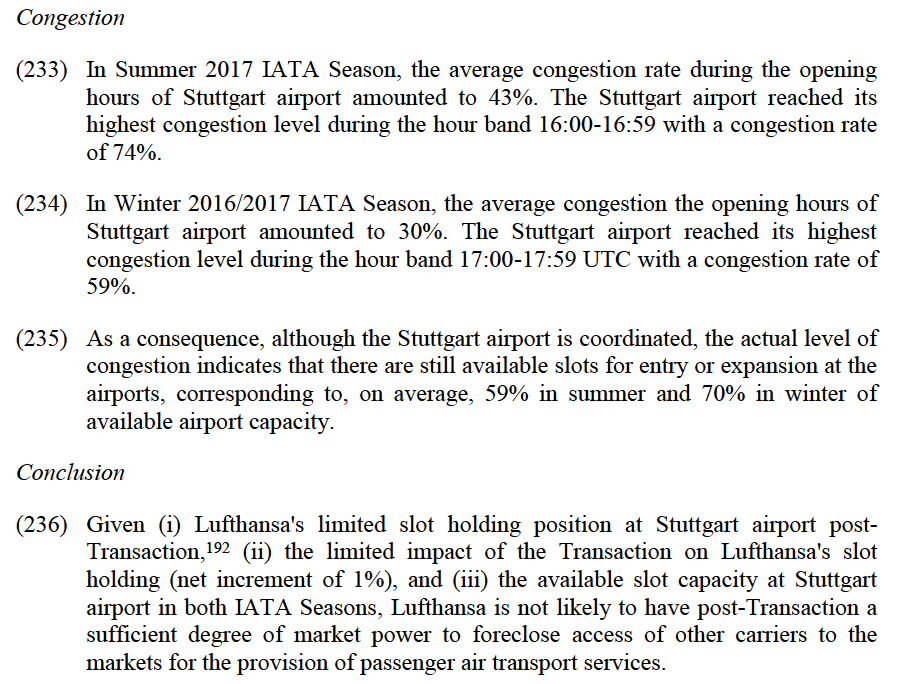
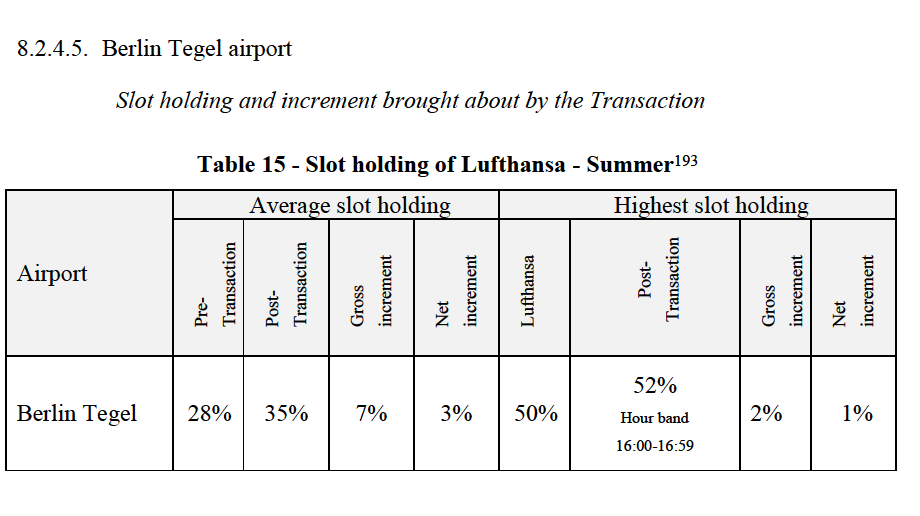

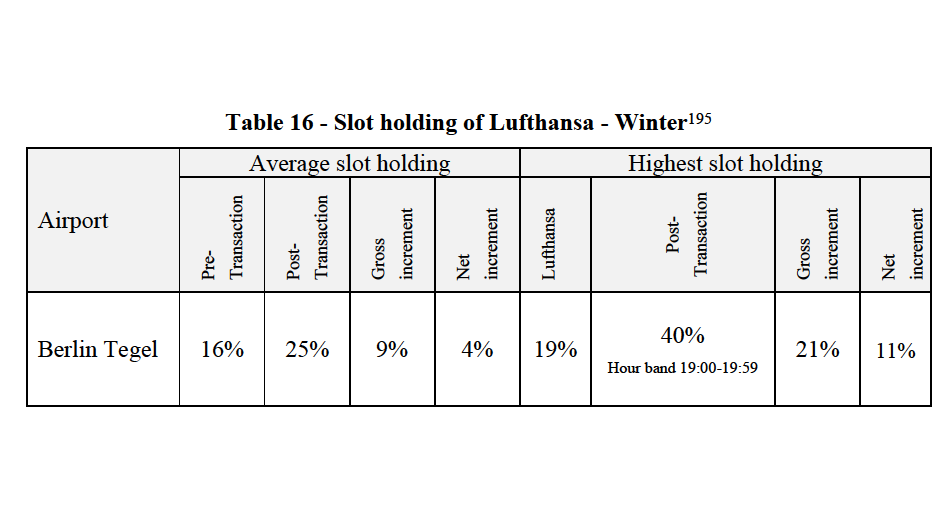
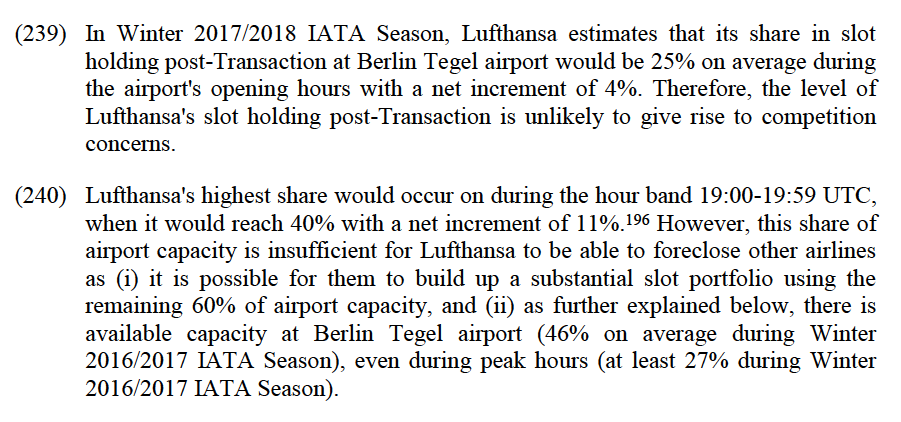
Congestion
(241) In Summer 2017 IATA Season, the average congestion rate during the opening hours of Berlin Tegel airport amounted to 62%. The Berlin Tegel airport reached its highest congestion level during the hour band 10:00-10:59 UTC with a congestion rate of 83%.
(242) In Winter 2016/2017 IATA Season, the average congestion rate during the Berlin Tegel airport's opening hours amounted to 54%. The Berlin Tegel airport reached its highest congestion level during the hour band 7:00-7:59 UTC with a congestion rate of 73%.
(243) As a consequence, although Berlin Tegel airport is coordinated, the actual level of congestion indicates that there are still available slots for entry or expansion at the airports, corresponding to, on average, 38% in summer and 46% in winter of available airport capacity.
Conclusion
(244) Given (i) Lufthansa's limited slot holding position at Berlin Tegel airport post-Transaction,197 and (ii) the available slot capacity at Berlin Tegel airport in both IATA Seasons, Lufthansa is not likely to have post-Transaction a sufficient degree of market power to foreclose access of other carriers to the markets for the provision of passenger air transport services.
8.2.4.6. Zurich airport
(245) Slots would be transferred to Lufthansa through the Transaction at Zurich airport for Summer IATA Season only. Therefore, the Commission will only assess Lufthansa's ability to foreclose access to the markets for the provision of passenger air transport from or to Zurich airport in Summer IATA Season.
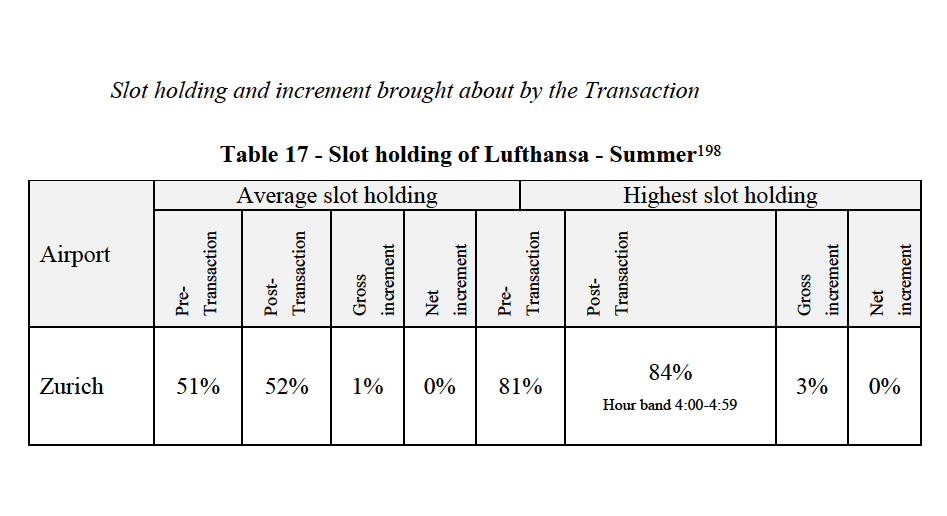
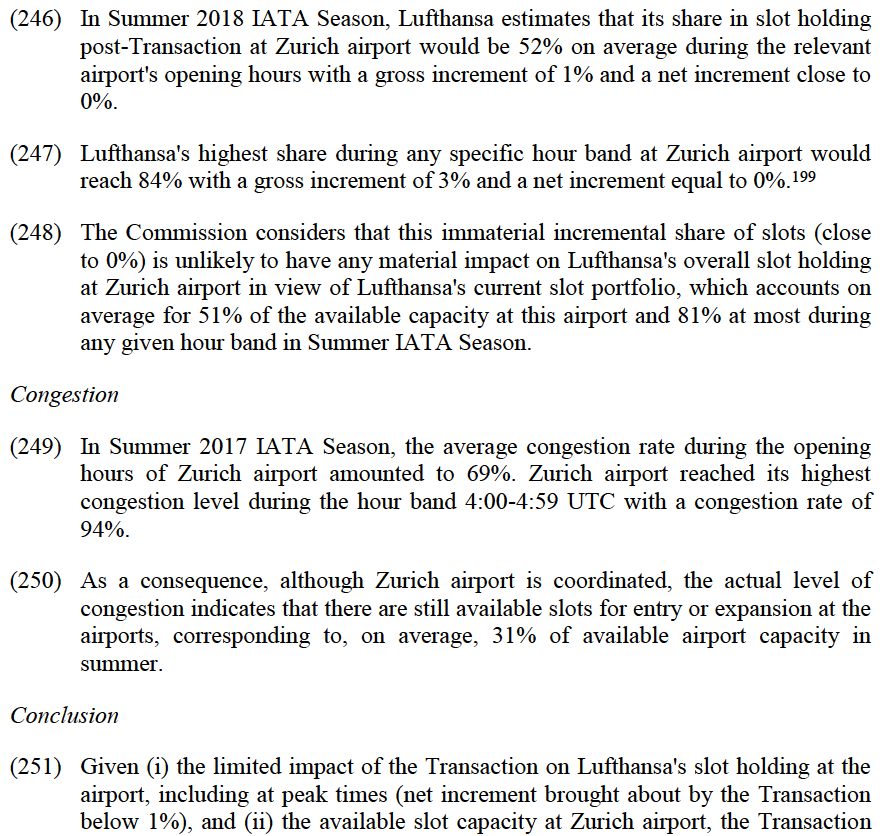

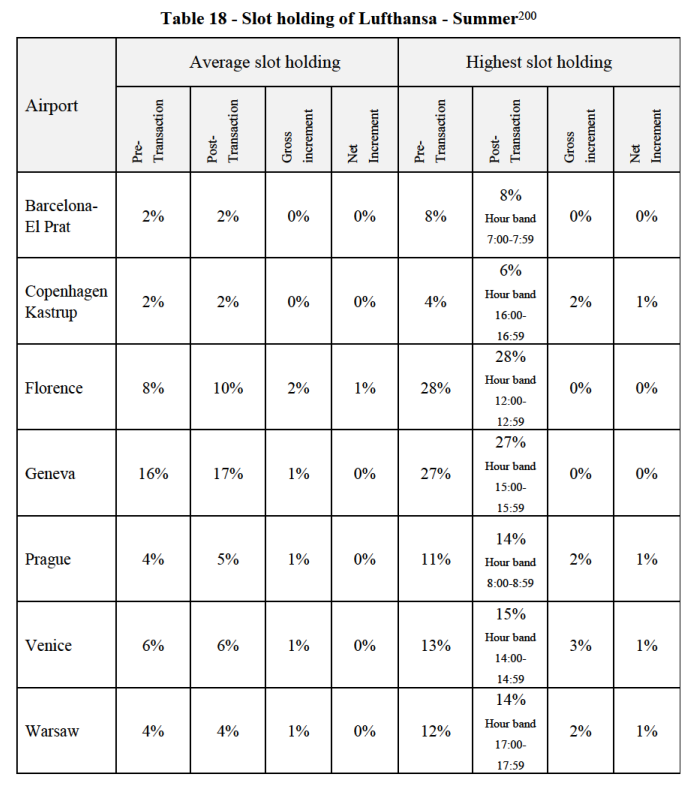
(252) In Summer 2018 IATA Season, Lufthansa estimates that its share in slot holding post-Transaction at each destination airport would be below 17% on average during the relevant airport's opening hours with a net increment inferior to 1%.
(253) Lufthansa's highest share during any specific hour band at each of the destination airports would reach no more than 28% with a net increment below 1%.
(254) Therefore, the level of Lufthansa's slot holding post-Transaction is unlikely to give rise to competition concerns. Furthermore, the limited incremental share of slots brought about the Transaction at these destination airports is unlikely to have any material impact on the slot holding of Lufthansa at these airports.
(255) As described in section 7.2.2.1, airport substitutability could be relevant for Barcelona-El Prat airport. However, Lufthansa has limited operations at Reus and Girona airports, which, according to Lufthansa, are located in the same catchment area as Barcelona-El Prat airport. In addition, the net increment in Lufthansa's operations brought about by the Transaction is de minimis (below 1%). The increment would be diluted if Reus and Girona airports were to be taken into account, and therefore, the competitive analysis does not change even when taking into account airport substitutability.
(256) Airport substitutability could also be relevant for Venice airport. As described in section 7.2.2.1, Lufthansa has no operations at Treviso airport, which, according to Lufthansa, is located in the same catchment area as Venice airport. In addition, the net increment in Lufthansa's operations brought about by the Transaction is de minimis (below 1%). The increment would be diluted if Treviso airport was to be taken into account, and therefore, the competitive analysis does not change even when taking into account airport substitutability.
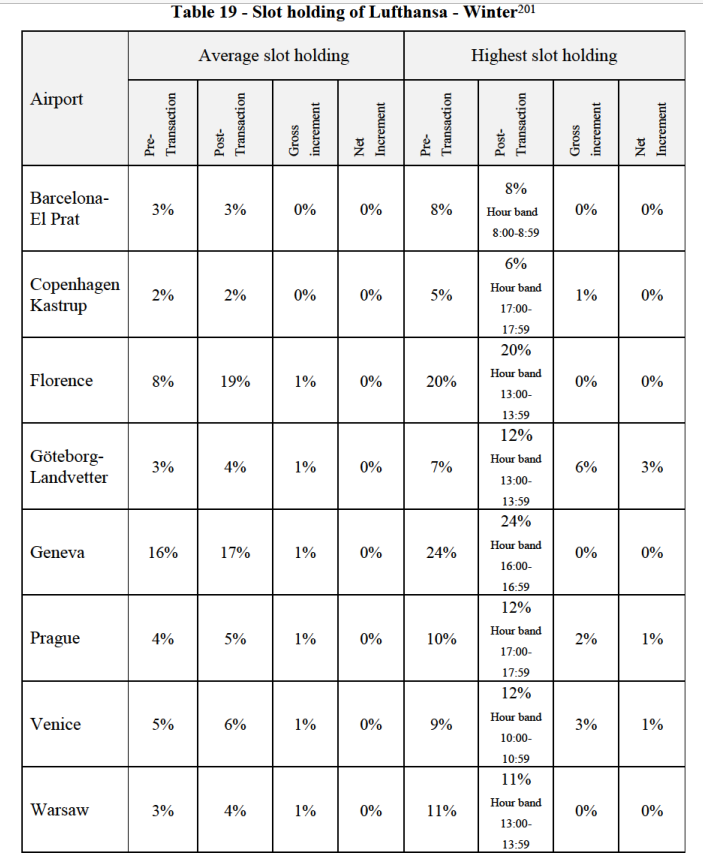

(258) Lufthansa's highest share during any specific hour band at each of the destination airports would reach no more than 24% with a net increment below 3%.
(259) Therefore, the level of Lufthansa's slot holding post-Transaction is unlikely to give rise to competition concerns. Furthermore, the limited incremental share of slots brought about the Transaction at these destination airports is unlikely to have any material impact on the slot holding of Lufthansa at these airports.
(260) As described in section 7.2.2.1, airport substitutability could be relevant for Barcelona-El Prat airport. However, Lufthansa has limited operations at Reus and Girona airports, which, according to Lufthansa, are located in the same catchment area as Barcelona-El Prat airport. In addition, the net increment in Lufthansa's operations brought about by the Transaction is de minimis (below 1%). The increment would be diluted if Reus and Girona airports were to be taken into account, and therefore, the competitive analysis does not change even when taking into account airport substitutability.
(261) Airport substitutability could also be relevant for Venice airport. As described in section 7.2.2.1, Lufthansa has no operations at Treviso airport, which, according to Lufthansa, is located in the same catchment area as Venice airport. In addition, the net increment in Lufthansa's operations brought about by the Transaction is de minimis (below 1%). The increment would be diluted if Treviso airport was to be taken into account, and therefore, the competitive analysis does not change even when taking into account airport substitutability.
Conclusion
(262) Given (i) Lufthansa's limited slot holding position at destination airports post-Transaction,202 and (ii) the absence of material impact of the Transaction on Lufthansa's slot portfolio in both IATA Seasons, Lufthansa is not likely to have post-Transaction a sufficient degree of market power to foreclose access of other carriers to the markets for the provision of passenger air transport services at the relevant airports.
8.2.5. Conclusion
(263) In light of the above, given Lufthansa's slot holding at Duesseldorf airport post-Transaction, the Commission considers that Lufthansa would likely have a dominant position at Duesseldorf airport in Summer IATA Season. However, Lufthansa would not have such a position in Winter IATA Season.
(264) In light of the above, given Lufthansa's slot holding at the other relevant airports post-Transaction during the relevant IATA Seasons, the Commission considers that Lufthansa would not have a dominant position at airports other than Duesseldorf.
(265) Considering the specific impact of the Transaction on Lufthansa's position at Duesseldorf airport, the Commission will assess whether Lufthansa would have the incentive to implement a foreclosure strategy at Duesseldorf airport and what the overall impact of such strategy on effective competition on the markets for passenger air transport from or to Duesseldorf airport would be in Summer IATA Season.
8.3. Incentive of Lufthansa to foreclose access to the markets for the provision of passenger air transport services
8.3.1. Conditions
(266) A dominant carrier at a relevant airport would in principle have a strong incentive to pursue a foreclosure strategy, as any new service or expansion by another carrier would be likely to introduce or increase competition on one of the dominant carrier's routes. Such dominant carrier would have a greater incentive than any other carrier at the airport to keep slots out of reach of other carriers. The incentive to foreclosure would also grow with the increased size of the slot portfolio it would control at the airport.
(267) Therefore, the Commission needs to analyse (i) the market shares of the merged entity in the relevant passenger air transport markets; and (ii) the relative capacity constraints faced by the merged entity and its competitors.
(268) In the specific framework of its assessment of Lufthansa's incentives to foreclose other air carriers' access to airports, the Commission will take account of its share of the market for passenger air transport at those airports and Lufthansa's fleet deployed in those airports.203
(269) Considering that the Commission finds that Lufthansa is likely to have the ability to foreclose access to the markets for the provision of passenger air transport services at Duesseldorf airport only, the assessment of Lufthansa's incentive will focus on Duesseldorf airport.
8.3.2. Assessment for Duesseldorf airport
(270) In 2016, three of the five largest operators at Duesseldorf airport were part of the Lufthansa Group (Eurowings/Germanwings, Lufthansa and SunExpress) which together transported 7.2 million passengers. Not taking account of Air Berlin (the first operator at Duesseldorf airport in 2016 with 7.5 million passengers), Lufthansa's largest competitor at Duesseldorf airport is Condor, with 0.9 million passengers (one eighth of Lufthansa Group's total number of passengers).204
(271) First, in terms of market shares at Duesseldorf airport (in number of passengers), Lufthansa had, prior to the Transaction, 43% of the total number of passengers in Winter IATA Season and 40% in Summer IATA Season. If the passengers that used to be carried by Air Berlin under the wetlease with LGW are notionally allocated to Lufthansa, Lufthansa's market share post-Transaction would reach 48% in Winter IATA Season and 44% in Summer IATA Season, even without considering the traffic that could be generated by the surplus slots.205
(272) In the Commission's view, those market shares would likely be sufficient to give an incentive to Lufthansa to engage in a foreclosure strategy.
(273) Through the Transaction, Lufthansa is transferred 450 weekly slots (254 LGW slots and 196 surplus slots) at Duesseldorf airport, corresponding to around 8 aircraft equivalents.206
(274) Second, in terms of capacity and capacity constraints, Lufthansa is already a home-base carrier at Duesseldorf airport (together with Condor, TUIfly, Germania and Air Berlin) and deploys the largest fleet, with 34 aircraft.207 The second largest carriers in terms of fleet (the Air Berlin Group set aside) are Condor and TUIfly (each with 4 aircraft), followed by Germania (3 aircraft).208
(275) Therefore, Lufthansa's dominant slot holding position post-Transaction would enable it to further increase its operations at Duesseldorf, with the equivalent of more than 40 aircraft, far ahead of any competitor's fleet (up to 4 aircraft). In addition, due to the shortage in slots at Duesseldorf airport, Lufthansa's competitors would be prevented from expanding their capacity or starting operation at Duesseldorf airport with a sufficient scale to operate efficiently and compete effectively with Lufthansa.
(276) As a consequence, given Lufthansa's large passenger air transport capacity and the possibility to increase it following the Transaction, Lufthansa will be able to capture the part of the demand from foreclosed competitors, given it an incentive to foreclose access to the markets for the provision of passenger air transport services.
8.3.2.1. Conclusion
(277) In light of the above, given Lufthansa's share of passengers at Duesseldorf airport, the capacity that Lufthansa can deploy and the constraints faced by its competitors at Duesseldorf airport, the Commission considers that Lufthansa would likely have the incentive to foreclose competitors' access to the markets for the provision of passenger air transport services at Duesseldorf airport, in particular in Summer IATA Season.
8.4. Overall effect on competition for passenger air transport
8.4.1. Conditions for anticompetitive effects of Lufthansa's dominant slot holding position
(278) Effective competition would be significantly harmed if the foreclosed air carriers play a sufficiently important role in the competitive process on the passenger air transport markets. The higher the proportion of carriers which would be foreclosed on these markets, the more likely the merger can be expected to result in a significant price increase in the passenger air transport markets and, therefore, to significantly impede effective competition therein.
(279) On that basis, the Commission will assess whether the creation of Lufthansa's dominant slot holding position at Duesseldorf airport post-Transaction would result in less effective competition for passenger air transport from or to Duesseldorf airport.
8.4.2. Assessment for Duesseldorf airport
(280) Lufthansa acknowledges that slot restrictions, hence barriers to entry and expansion, exist at Duesseldorf airport, which has a slot utilisation rate of 91%. Nevertheless, Lufthansa claims that slot restrictions are limited to peak business travel times and that entry in the Rhine-Ruhr catchment area remains easy at Cologne-Bonn, Dortmund or Weeze airports.209
(281) Neither the results of the market investigation nor Lufthansa's internal documents or submissions support these claims.
(282) First, a number of competitors underline that there are few available slots at Duesseldorf airport.210 They claim that the Transaction would worsen the slot situation at Duesseldorf airport,211 thus making their entry or expansion more difficult and hampering their plans to enter or expand Duesseldorf routes in Summer 2018 IATA Season. For example, an air carrier specifies that the "[l]ack of slot availability at Dusseldorf may impact [its] future operations,"212 while another competitor states that, for the Summer 2018 IATA Season, "[s]ales have started, it is very unlikely to obtain all the slots needed, especially in TXL, DUS, ZRH."213
(283) Second, Lufthansa confirmed that it had "unmet slot needs" for Summer 2018 IATA season at Duesseldorf airport, which could only be partly satisfied by the Transaction.214
(284) In this regard, the following internal document illustrates the extent to which the Transaction was meant to overcome the slot restrictions at Duesseldorf airport and enable Lufthansa to implement its expansion plan for the Summer 2018 IATA season. At the same time, it shows how Lufthansa anticipates that the number of slots left available to its competitors at Duesseldorf airport after the Transaction would fall short of their demand.
[…]
Source: Form CO, Section 5.4 Documents, […].
(285) The Commission notes that, when slot holding at a given airport is very fragmented and slots are allocated to a very large number of small air carriers, the latter are unable to translate these slots into a viable alternative to dominant air carriers.215
(286) This was confirmed by a number of competitors, which indicate that the Transaction would prevent them from benefitting from the advantages of holding a large portfolio of slots. Such advantages include operational flexibility and efficiency through swapping slots within their own operations, as well as bargaining power and volume discounts on the services provided by airport managers and ground handling companies.216 As a consequence, a number of respondents claim that the Transaction would have a detrimental effect on the efficient operations of Lufthansa's competitors.217
(287) In addition, post-Transaction, Lufthansa would face limited competition at Duesseldorf airport. Lufthansa's fleet based at Duesseldorf airport would, with an increment of […] aircraft, be much larger than the fleet of any of its competitors.218 This significant difference in slot holdings and deployed capacity means that Lufthansa's competitors are not likely to have a sufficiently large portfolio of slots and capacity to react to any anti-competitive behaviour by Lufthansa. The Transaction may thus result in a lessening of competition from those air carriers.
8.4.3. Conclusion
(288) In light of the above, given that the Transaction would result in a disadvantage for its rivals by further increasing barriers to enter or expand at Duesseldorf airport, in particular in Summer IATA Season, and that most of Lufthansa's competitors could be foreclosed, the Commission considers that Lufthansa's dominant slot holding position would likely have a significant detrimental effect on competition in the markets for the provision of passenger air transport services at Duesseldorf airport, in particular in Summer IATA Season.
8.5. Conclusion
(289) In light of the above, the Commission considers that the Transaction would likely result in the creation of a dominant slot holding position for Lufthansa at Duesseldorf airport in Summer IATA Season. As a result, Lufthansa would have the ability and incentive post-Transaction to foreclose access of its competitors to the markets for the provision of passenger air transport services at Duesseldorf airport, leading to anti-competitive effects on the markets for the provision of passenger air transport services from and to Duesseldorf airport. On that basis, the Commission concludes that the Transaction raises serious doubts as concerns the markets for passenger air transport from or to Duesseldorf airport in Summer IATA Season.
(290) For the Winter IATA Season, considering Lufthansa's lack of a dominant position at Duesseldorf airport, the Commission concludes that the Transaction does not raise serious doubts as concerns the markets for passenger air transport from or to Duesseldorf airport.
(291) For the other relevant airports, considering the marginal impact of the Transaction on Lufthansa's slot holdings, the Commission concludes that the Transaction does not raise serious doubts as concerns the markets for passenger air transport from or to the airports, under any plausible market definition.
9. PROPOSED REMEDIES
(292) In order to address the serious doubts raised by the Transaction, Lufthansa submitted a first set of commitments on 30 November 2017 (the "commitments of 30 November 2017").
(293) The commitments of 30 November 2017 were not sufficiently clear to allow for a market test, as respondents would not have been able to sufficiently understand the scope of the proposed commitments.
(294) Following exchanges with the Commission on the precise scope and content of the proposed commitments, Lufthansa submitted a second set of commitments on 5 December 2017 (the "commitments of 5 December 2017"). The complete set of annexes to those commitments was provided on 6 December 2017.
64
(295) The commitments of 5 December 2017 included measures aimed at addressing the serious doubts resulting from Lufthansa's acquisition of LGW and its effects at Duesseldorf airport. More specifically, Lufthansa committed to only receive slots that were used for flights operated by LGW from or to Duesseldorf airport using its fleet of Dash 8 Q400 turbo-prop aircraft.219
(296) The commitments of 5 December 2017 were subjected to a market test.
(297) On 15 December 2017, Lufthansa submitted a third set of commitments (the "commitments of 15 December 2017") to address the serious doubts resulting from Lufthansa's acquisition of LGW in the Summer IATA Season.
(298) In the commitments of 15 December 2017, Lufthansa committed to amend the sale and purchase agreement it has entered into with Air Berlin to the effect that Lufthansa will limit the slots at Duesseldorf airport for the Summer IATA Season to be transferred through LGW to slots for two aircraft equivalents. The schedule to the commitments of 15 December 2017 contains the list of slots that Lufthansa will receive, after amendment of the sale and purchase agreement.220 The commitments of 15 December 2017 stipulate that Lufthansa will provide the documents evidencing the amendments to the sale and purchase agreement to the Commission no later than 10 working days after the date of this Decision.
(299) According to Lufthansa, as a result of the commitments of 15 December 2017, the slots that Lufthansa will receive through the Transaction will not go beyond the slots previously used by LGW for its operations at Duesseldorf airport and, in fact, will constitute only a portion of those slots. With the commitments of 15 December 2017, the Transaction would cause a net increment of Lufthansa's total slot holding at Duesseldorf airport in the Summer IATA Season of only about 1%. Lufthansa concludes that this increase is clearly of a de minimis nature and cannot raise serious doubts as to the Transaction's compatibility with the internal market.221
10. ASSESSMENT OF THE PROPOSED REMEDIES
10.1. Analytical framework
(300) As set out in the Commission Notice on remedies,222 the Commission assesses the compatibility of a notified concentration with the internal market on the basis of its effect on the structure of competition in the EU. Where a concentration raises serious doubts which could lead to a significant impediment to effective competition, the parties may seek to modify the concentration so as to resolve the serious doubts identified by the Commission with a view to having the merger cleared.
(301) The Commission enjoys a broad discretion in assessing whether these remedies constitute a direct and sufficient response capable of dispelling any such doubts.223
(302) In assessing whether or not the remedies will restore effective competition, the Commission considers inter alia the type, scale and scope of the remedies by reference to the structure and the particular characteristics of the market in which these serious doubts arise. The Commission highlights, however, that commitments in Phase I can only be accepted when the competition problem is readily identifiable and can easily be remedied.
10.2. The commitments of 5 December 2017
(303) As detailed in section 8, the Transaction would raise serious doubts on its compatibility with the internal market in relation to the slot portfolio holding of Lufthansa at Duesseldorf airport in Summer IATA Season.
(304) In particular, the pre-Transaction slot holding of Lufthansa is 39% at Duesseldorf airport. After the Transaction, Lufthansa would have an increased slot holding of 54%. The net increment resulting from the Transaction would be 5%.224
(305) The commitments of 5 December 2017 would result in Lufthansa obtaining fewer slots. More specifically, taking into account these commitments, Lufthansa would have a slot holding of 52% at Duesseldorf airport after the Transaction. The net increment would be 3%.225
(306) In their response to the market test, a majority of competitors considered that the commitments of 5 December 2017 would not clearly remove the Transaction's competition concerns relating to Lufthansa's slot holding position at Duesseldorf airport after the Transaction, while the opinions of other market participants appeared split.
(307) Several competitors pointed out that, even with the commitments of 5 December 2017, the Transaction would still strengthen Lufthansa's strong position at Duesseldorf airport through the acquisition of the LGW slots.226 One airline acknowledged that the commitments were a "slight improvement" but pointed out that they nonetheless did not remove the Transaction's anti-competitive effects because "DUS will remain slot congested, and the concentration of limited slots in lesser hands will increase".227
(308) Among the few substantiated replies from market participants other than competitors, several pointed out that, even if Lufthansa acquired fewer slots as a result of the commitments of 5 December 2017, it would still obtain slots from the slot pool. An airport operator explained that "in case of a return of the slots to the slot pool, LH Group would still have the opportunity to get a significant share of the slots in question from the "open market" and thus gain an even more dominant competitive position at DUS."228
(309) The Commission considers that, even if the commitments of 5 December 2017 would reduce the slots that Lufthansa acquires, the Transaction would still result in a net increment of 3% and bring Lufthansa's total slot holding after the Transaction to 52%, resulting in a dominant slot holding position for Lufthansa at Duesseldorf airport and allowing it to prevent the entry and expansion of competitors at that airport.
(310) In this context, and considering in particular the value of the net increment still brought about by the Transaction, even with the commitments, it was not sufficiently established that the commitments of 5 December 2017 eliminate all serious doubts identified during the Phase I investigation in a clear-cut manner.
10.2.1. Conclusion
(311) The commitments of 5 December 2017 did not eliminate the serious doubts as to the compatibility of the Transaction with the internal market.
10.3. The commitments of 15 December 2017
(312) The commitments of 15 December 2017 take into account in a comprehensive manner the shortcomings of the commitments of 5 December 2017, as identified in particular in the market test.
(313) By limiting the transfer of Duesseldorf slots for Summer IATA Season through LGW to slots for two aircraft equivalents,229 Lufthansa's slot holding at Duesseldorf airport would be limited to 50%. Importantly, the net increment would only be a marginal 1%, indicating that the specific effects of the Transaction would be very limited.230
(314) The Commission also notes that the slots that Lufthansa will be transferred include only two daily early morning (peak time) departure slots.
(315) The commitments of 15 December 2017 do not reduce the number of slots that Lufthansa will be transferred for the Winter IATA Season. However, since Lufthansa's slot holding in the Winter IATA Season at Duesseldorf airport does not raise competition concerns, the commitments do not need to address the Winter IATA Season.
(316) For the reasons outlined above, the commitments of 15 December 2017 are sufficient to eliminate the serious doubts as to the compatibility of the Transaction with the internal market, considering that (i) the net increment brought about by the Transaction is very limited, and (ii) Lufthansa's slot holding would be limited to 50%, even taking account of the slots that Lufthansa may be allocated from the slot pool.
(317) In addition, as the commitments of 15 December 2017 consist in the amendment of the sale and purchase agreement to reduce the number of slots to be transferred, they are capable of being implemented effectively within a short period of time.
(318) Under the first sentence of the second subparagraph of Article 6(2) of the Merger Regulation, the Commission may attach to its decision conditions and obligations intended to ensure that the undertakings concerned comply with the commitments they have entered into vis-à-vis the Commission with a view to rendering the concentration compatible with the internal market.
(319) The achievement of the measure that gives rise to the structural change of the market is a condition, whereas the implementing steps which are necessary to achieve this result are generally obligations on the parties. Where a condition is not fulfilled, the Commission's decision declaring the concentration compatible with the internal market no longer stands. Where the undertakings concerned commit a breach of an obligation, the Commission may revoke the clearance decision in accordance with Article 8(6) of the Merger Regulation. The undertakings concerned may also be subject to fines and periodic penalty payments under Articles 14(2) and 15(1) of the Merger Regulation.
(320) The commitments of 15 December 2017 constitute obligations attached to this Decision.
11. CONCLUSION
(321) For the above reasons, the Commission has decided not to oppose the notified operation as modified by the commitments annexed to the Decision and to declare it compatible with the internal market and with the functioning of the EEA Agreement, subject to full compliance with the obligations contained in the commitments annexed to the present decision. This decision is adopted in application of Article 6(1)(b) in conjunction with Article 6(2) of the Merger Regulation and Article 57 of the EEA Agreement.
FOOTNOTES :
1 OJ L 24, 29.1.2004, p. 1 (the "Merger Regulation"). With effect from 1 December 2009, the Treaty on the Functioning of the European Union ("TFEU") has introduced certain changes, such as the replacement of "Community" by "Union" and "common market" by "internal market". The terminology of the TFEU will be used throughout this decision.
2 OJ L 1, 3.1.1994, p. 3 (the "EEA Agreement").
3 Publication in the Official Journal of the European Union No C379, 10.11.2017, p. 14.
4 Under Council Regulation (EEC) No 95/93 of 18 January 1993 on common rules for the allocation of slots at Community airports (the "Slot Regulation"), slots are defined as the permission given to an air carrier to use the full range of airport infrastructure necessary to operate an air service at a coordinated airport on a specific date and time for the purpose of landing or take-off (see Article 2(a) of the Slot Regulation).
5 Annex 08a to the Form CO, "Agreement for the sale and purchase of the Air Berlin Touristic and LGW Wet-Lease Business", Article 7.6.
6 OJ L 114, 30.4.2002, p. 73.
7 SunExpress is a joint venture between Lufthansa and Turkish Airlines. In line with Lufthansa's submission (Form CO, paragraph 3), SunExpress is considered as part of the Lufthansa Group for the purpose of this Decision.
8 Star Alliance was created by five airlines in 1997 as the first global aviation alliance. Star Alliance has now 28 member airlines, which offer connections across a global network. A project company based in Frankfurt, Germany, coordinates Star Alliance's activities, including co-locations at airports, infrastructure, communication initiatives and other services.
9 NIKI is an indirect wholly-owned subsidiary of Air Berlin. It is an Austrian airline with its corporate seat in Vienna, Austria. NIKI's fleet comprises 35 aircraft: 21 Airbus A321 aircraft and 14 Boeing 737 family aircraft. On 13 December 2017, after Lufthansa excluded NIKI from the scope of the Transaction, NIKI filed a petition for the opening of insolvency proceedings with the court of Berlin-Charlottenburg in Germany. It announced that it would discontinue operating further flights as of the date of its petition.
10 Annex 08a to the Form CO, "Agreement for the sale and purchase of the Air Berlin Touristic and LGW Wet-Lease Business" and its schedules (Annex 08b).
11 This statement and, more broadly, this decision are without prejudice to the assessment of the legality of the transfer of slots under the Slot Regulation.
12 The International Air Transport Association (IATA) is the trade association for the world's airlines, representing some 280 airlines or 83% of total air traffic.
13 Form CO, paragraph 11.
14 These conditions notably consists in (i) ensuring that the leases which Lufthansa would have entered into for aircraft used by NIKI or LGW can easily be transferred to NIKI, LGW or its acquirers, without entitling Lufthansa to financial penalties or a premium; and (ii) giving NIKI, LGW or its acquirers the option to lease or buy at market terms the aircraft used by NIKI or LGW, which Lufthansa would have purchased.
15 Turnover calculated in accordance with Article 5(1) of the Merger Regulation and the Commission Consolidated Jurisdictional Notice (OJ C95, 16.4.2008, p. 1).
16 Turnover calculated under the "point of sale" method, which consists in allocating the turnover to the country where the ticket sale occurred. Lufthansa only calculates its turnover on the basis of the point of sale method, but also provided its turnover on the basis of the "point of origin" method, which consists in allocating the revenue from an individual route operated by an air carrier to the country where the place of departure of the flight is located. Lufthansa does not account for its turnover on the basis of the "50/50 split" method, which consists in allocating the revenue from an individual route operated by an air carrier in a 50%/50% ratio to the country of origin and the country of final destination so as to take into account the cross border character of the service provided. Lufthansa was therefore unable to provide turnover on this basis. The turnover of NIKI was calculated under the point of sale method, but also on the basis of the 50/50 split and the point of origin methods. The turnover of LGW was calculated on the basis of the point of sale method only, since LGW's turnover almost exclusively consisted of the revenue generated through the intra-group wetlease. In any case, the threshold of Article 1(2) of the Merger Regulation is met for NIKI and LGW's combined turnover under any method, since NIKI's turnover alone exceeds EUR 250 million under any allocation method.
17 C-202/06, ECLI:EU:C:2007:814, paragraph 43 – Cementbouw v Commission.
18 C-202/06, ECLI:EU:C:2007:814, paragraph 39 – Cementbouw v Commission.
19 Commission Consolidated Jurisdictional Notice under Council Regulation (EC) No 139/2004 on the control of concentrations between undertakings, paragraph 156.
20 See paragraph 12 of this Decision.
21 Form CO, paragraph 1317.
22 Form CO, paragraphs 1324-1325.
23 See paragraph (15) of this Decision.
24 Decision of 30 January 2017 in Case B9-190/16.
25 Form CO, paragraph 1327.
26 See e.g. Cases M.5440 Lufthansa/Austrian Airlines, paragraph 354; M.3770 – Lufthansa/Swiss, paragraph 34.
27 Recital (4) of the Commission Proposal for a Regulation of the European Parliament and of the Council on common rules for the allocation of slots at European Union airports (COM/2011/827 final of 01 December 2011).
28 Slot Regulation, first recital: "Whereas there is a growing imbalance between the expansion of the air transport system in Europe and the availability of adequate airport infrastructure to meet that demand; whereas there is, as a result, an increasing number of congested airports in the Community."
29 Slot Regulation, Article 8(2).
30 Slot Regulation, Article 10(6).
31 The coordinator is the person responsible for the allocation of slots (Slot Regulation, Article 4(5)). According to the first sentence of Article 8a(2) of the Slot Regulation, "[t]he transfers or exchanges referred to in paragraph 1 shall be notified to the coordinator and shall not take effect prior to the express confirmation by the coordinator."
32 See e.g. Cases M.7541 IAG/Aer Lingus, paragraph 14; M.7333 Alitalia/Etihad, paragraph 63; M.6447 IAG/bmi, paragraph 31.
33 Form CO, paragraph 1338.
34 Form CO, paragraph 1480.
35 Replies to Q1 – Questionnaire to Competitors, questions 4.1 and 4.2. For example: "However, the O&D city-pair approach is not sufficient to assess all the possible impacts of the Transaction as it fails to adequately capture certain key competition parameters (including supply-side considerations, potential competition and barriers to entry) that are relevant to Lufthansa’s market position post-Transaction" (reply of an air carrier to Q1 – Questionnaire to Competitors, question 4.2).
36 Replies to Q1 – Questionnaire to Competitors, question 4.2.
37 See e.g. Cases M.6447 IAG/bmi, paragraphs 153-157; M.5141 KLM/ Martinair, paragraph 175.
38 See e.g. Cases M.6447 IAG/bmi, paragraph 136 et seq.; M.5141 KLM/ Martinair, paragraphs 195-196.
39 Replies to Q1 – Questionnaire to Competitors, question 4.1.
40 COM/2011/827 final of 01 December 2011.
41 See e.g. Case M.6447 IAG/bmi, paragraphs 136-157.
42 Case M.7270 Český Aeroholding/Travel Service/České aerolinie, paragraph 138.
43 Case M.6447 IAG/bmi, paragraph 483.
44 See e.g. Case M.6447 IAG/bmi, paragraphs 492-506.
45 As mentioned in paragraph 48, the outcome of the market investigation confirms this approach.
46 See e.g. Cases M.8361 – Qatar Airways/Alisarda/Meridiana, paragraph 29; M.7333 – Alitalia/Etihad, paragraph 82; M.6663 – Ryanair/Aer Lingus III, paragraph 65.
47 These are: Berlin Tegel airport, Cologne-Bonn airport, Duesseldorf airport, Geneva airport, Hamburg airport, Munich airport, Nuremberg airport, Saarbrücken airport, Salzburg airport, Stuttgart airport, Zurich airport.
48 These are: Barcelona-El Prat airport, Bologna airport, Copenhagen Kastrup airport, Florence airport, Göteborg Landvetter Airport, Prague airport, Venice airport, Warsaw airport.
49 These are 7 airports in Germany, Austria and Switzerland (Berlin Tegel airport, Duesseldorf airport, Geneva airport, Hamburg airport, Munich airport, Stuttgart airport, Zurich airport) and 7 airports in other EU Member States (Barcelona-El Prat airport, Copenhagen Kastrup airport, Florence airport, Göteborg Landvetter airport, Prague airport, Venice airport, Warsaw airport).
50 Under the Slot Regulation, a coordinated airport is defined as an airport with a high level of congestion where demand exceeds capacity during the relevant period and where, in order to land or take off, it is necessary for an air carrier to have a slot allocated by a coordinator.
51 Substitutability between Hamburg and Lübeck airports is not considered, since no scheduled flight has been operated from or to Lübeck airport since 2016 (See http://www.aerotelegraph.com/wizzair-startet-fluege-ab-hamburg-laesst-luebeck-fallen-insolvenz-pleite and reply from Hamburg Airport to Q6 – Questionnaire to Airport Managers, question 11.1: "LBC is currently no substitute for HAM due to lack of commercial flights").
52 See Case M.5335 – Lufthansa/ SN Airholding, paragraphs 205-206.
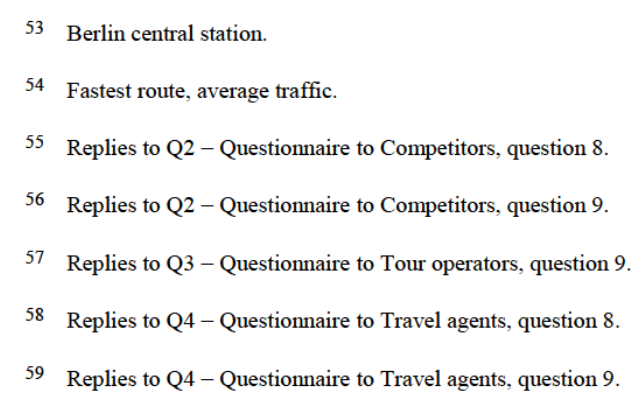
60 Reply of Flughafen Berlin Brandenburg to Q6 – Questionnaire to Airport Managers, question 11.1. In particular: "SXF is more a low-cost airport, and 35 km away from TXL airport. The tour operators sell both airports to their customers. This is mainly due to the location of the airports, and the different catchment areas (TXL –northern Berlin catchment area until HAM), (SXF more southern Berlin catchment until DRS and LEJ) From TXL we have tour operator bookings on different airlines, as well as from SXF airport (e.g. Condor, Germania). For normal passengers using scheduled airlines , it depends on the travel reasons and destinations. Cheaper fares with LCCs are mainly found at SXF airport."
61 Form CO, paragraph 771. Lufthansa even argues that an enlarged catchment area, including Frankfurt and Eindhoven airports, should be considered (Form CO, paragraph 200).
62 See cases M.5440 – Lufthansa/Austrian Airlines, paragraph 125; M.3940 – Lufthansa/Eurowings, paragraph 96.


71 Replies to Q6 – Questionnaire to Airport Managers, question 11.
72 Replies to Q3 Questionnaire to Tour operators, question 9. For example: "A Client living in CGN would NEVER depart in DUS - and vice versa" (reply of a tour operator to Q3 Questionnaire to Tour operators, question 9.1).
73 Replies to Q4 Questionnaire to Travel agents, questions 8 and 9.
74 Lufthansa also indicates that Nuremberg airport, which is only 170 km away from MUC, is another competitive option for price-sensitive touristic travellers constraining pricing on airports in the South Bavaria catchment (Form CO, paragraph 223).
75 See Case M.6663 – Ryanair/Aer Lingus III, paragraph 265.
76 See Case M.5335 – Lufthansa/SN Airholding, footnote 185.

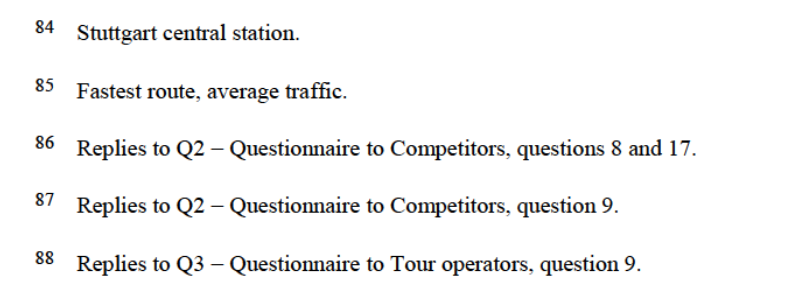
89 Replies to Q4 Questionnaire to Travel agents, question 8.
90 Replies to Q4 Questionnaire to Travel agents, questions 8 and 9.
91 Reply of Stuttgart Airport to Q6 – Questionnaire to Airport Managers, questions 11 and 11.1.
92 See Cases M.5440 – Lufthansa/Austrian Airlines, paragraph 223 et seq. for Vienna-Basel and Vienna-Zurich; M.3770 – Lufthansa/Swiss for e.g. Zurich-Munich and Basel-Munich, paragraph 51 et seq.
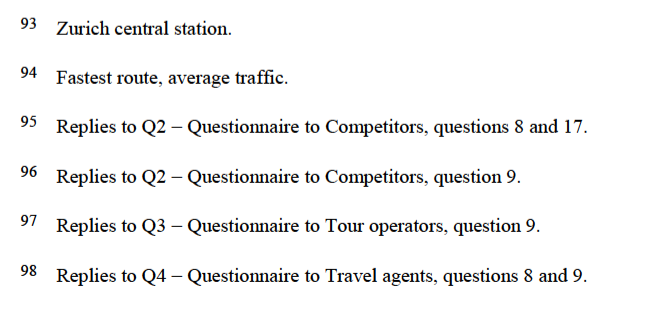
99 Press release of 1 December 2011 accompanying the Airport Package (http://europa.eu/rapid/press-releaseMEMO-11-857en.htm).
100 See e.g. Cases M.7270 Český Aeroholding/Travel Service/České aerolinie, paragraph 50; M.7008 – Aena International/Axa PE/LLAGL, paragraph 12.
101 See e.g. Case M.7398 MIRAEL/ Ferrovial/NDH1, paragraph 19.
102 See e.g. Cases M.5652 – GIP/Gatwick Airport, paragraph 14; M.4164 – Ferrovial/Quebec/GIC/BAA, paragraphs 15-17; M.3823 – MAG/Ferrovial Aeropuertos/Exeter Airport, paragraphs 16-19;
103 Reply of Flughafen Berlin Brandenburg to Q6 – Questionnaire to Airport Managers, question 6.1.1.
104 Reply of Flughafen Berlin Brandenburg to Q6 – Questionnaire to Airport Managers, question 5.3.
105 Reply of Flughafen Berlin Brandenburg to Q6 – Questionnaire to Airport Managers, question 11.1.
106 Under the 8th Edition of Worldwide Slot Guidelines issued by IATA (effective 1 January 2017), a Level 3 airport "is one where: a) Demand for airport infrastructure significantly exceeds the airport’s capacity during the relevant period; b) Expansion of airport infrastructure to meet demand is not possible in the short term; c) Attempts to resolve the problem through voluntary schedule adjustments have failed or are ineffective; and d) As a result, a process of slot allocation is required whereby it is necessary for all airlines and other aircraft operators to have a slot allocated by a coordinator in order to arrive or depart at the airport during the periods when slot allocation occurs." A Level 3 airport under the IATA Worldwide Slot Guidelines corresponds to a coordinated airport under the Slot Regulation.
107 Under the Slot Regulation, a schedules facilitated airport is "an airport where there is potential for congestion at some periods of the day, week or year which is amenable to resolution by voluntary cooperation between air carriers and where a schedules facilitator has been appointed to facilitate the operations of air carriers operating services or intending to operate services at that airport."
108 Under the 8th Edition of Worldwide Slot Guidelines issued by IATA (effective 1 January 2017), a Level 2 airport "is one where there is potential for congestion during some periods of the day, week or season, which can be resolved by schedule adjustments mutually agreed between the airlines and facilitator." A Level 2 airport under the IATA Worldwide Slot Guidelines corresponds to a schedules facilitated airport under the Slot Regulation.
109 Form CO, paragraph 1585.
110 See website of Duesseldorf airport: https://www.dus.com/~/media/fdg/duscom/konzern/unternehmen/zahlenundfakten/geschaeftsbericht/dusgb2016englsingle%20pages.pdf
111 See website of Cologne-Bonn airport: https://wwwkoeln-bonn-airport.de/en/company/facts-figureshtml
112 See website of Dortmund airport: https://www.dortmund-airport.com/eb81bc038b14a99b/facts-figures and website of Weeze airport: http://unternehmen.airport-weeze.com/en/shortprofile.html
113 See Annual Report 2016 of Duesseldorf airport: https://www.dus.com/~/media/fdg/duscom/konzern/unternehmen/zahlenundfakten/geschaeftsbericht/dusgb2016englsingle%20pages.pdf. The positioning of Duesseldorf airport explains why LGW served short-haul routes into Duesseldorf as a feeder for Air Berlin's long-haul operations.
114 See Annual Report 2016 of Cologne-Bonn airport: https://wwwkoeln-bonn-airport.de/uploads/txdownload/KBAGeBer2016englWEB100dpi20170412.pdf
115 See Annual Report 2016 of Dortmund airport: https://cdn0.scrvt.com/airportdtm/6e268df30ae08e6e/ee0ea9f7a643/DTM-Geschaeftsbericht2016-DE.PDF
116 See website of Weeze airport: http://unternehmen.airport-weeze.com/en/shortprofile.html. Lufthansa declares that Ryanair has "single-handedly" transformed Weeze into the third largest airport in Rhine-Ruhr since setting up a base there in 2007 (Form CO, paragraph 1586).
117 "[A]n airline can be exploited by its suppliers as it cannot easily switch its operations to another airport" (reply of an air carrier to Q1 – Questionnaire to Competitors, question 34.3.1).
118 For literature on that subject, see e.g. The Market power of Airports, Regulatory Issues and Competition between Airports by Bülent Hancioglu, July 2008 (http://userpage.fu-berlin.de/jmueller/gapprojekt/downloads/gappapers/HanciogluMarketpowerofAirportsRegulatoryjul08.pdf)
119 Form CO, Section 5.4 Documents, […]
120 Form CO, paragraphs 1606-1607.
121 See Annual Traffic Report 2016 of Munich airport: http://userpage.fu-berlin.de/jmueller/gapprojekt/downloads/gappapers/HanciogluMarketpowerofAirportsRegulatoryjul08.pdf
122 See website of Memmingen airport: https://www.allgaeu-airport.com/home/company/memmingen-airport/facts-figures-2/
123 See Annual Traffic Report 2016 of Munich airport: http://userpage.fu-berlin.de/jmueller/gapprojekt/downloads/gappapers/HanciogluMarketpowerofAirportsRegulatoryjul08.pdf
124 Form CO, paragraph 1610.
125 See website of Stuttgart airport: http://www.stuttgart-airport.com/company-information/facts-and-figures
126 See Development of passenger traffic at Karlsruhe/Baden-Baden airport: https://www.baden-airpark.de/wp-content/uploads/Passagiereengl.pdf
127 See website of Stuttgart airport: http://www.stuttgart-airport.com/company-information/facts-and-figures
128 See website of Karlsruhe/Baden-Baden airport: https://www.baden-airpark.de/en/company/company/
129 Form CO, paragraph 1598.
130 See Facts and Figures 2016 of Zurich airport: https://www.zurich-airport.com/~/media/flughafenzh/dokumente/blaetterkatalog/broschurezahlenfakten2016en1.pdf
131 See website of Basel airport: https://www.euroairport.com/en/euroairport/company/about-us/presentationhtml
132 See Facts and Figures 2016 of Zurich airport: https://www.zurich-airport.com/~/media/flughafenzh/dokumente/blaetterkatalog/broschurezahlenfakten2016en1.pdf
133 See website of Basel airport: https://www.euroairport.com/en/euroairport/company/about-us/presentationhtml. The first long-haul flight appears to be foreseen for Summer 2018 to Montreal.
134 Guidelines on the assessment of horizontal mergers under the Council Regulation on the control of concentrations between undertakings, OJ C 31, 05.02.2004, p. 5-18.
135 Form CO, paragraph 26.
136 Form CO, paragraph 1435.
137 Annexes to the emails from Air Berlin of 17 and 18 September 2017, containing the overview of the offers received by Air Berlin, indicating the interested parties as well as the assets of Air Berlin that they are interested in.
138 Form CO, Section 5.4 Documents, […].
139 Although the title of the document refers to NIKI only, its content covers both NIKI and LGW.
140 Form CO, Section 5.4 Documents, […].
141 Guidelines on the assessment of horizontal mergers under the Council Regulation on the control of concentrations between undertakings, OJ C 31, 5 February 2017, p. 5.
142 Form CO, paragraph 1581.
143 Replies to Q2 – Questionnaire to Competitors, question 34; Q3 – Questionnaire to Tour operators, question 16; Q6 – Questionnaire to Airport Managers, question 14.
144 Replies to Q6 – Questionnaire to Airport Managers, question 14.1.
145 Reply of an air carrier to Q2 – Questionnaire to Competitors, question 34.1.
146 Reply of a tour operator to Q3 – Questionnaire to Tour operators, question 16.1.
147 Reply of an air carrier to Q2 – Questionnaire to Competitors, question 34.1.
148 Reply of an air carrier to Q2 – Questionnaire to Competitors, question 34.2.
149 "Slot hoarding" involves the operation of small aircraft and/or low load factors in order to keep slots rather than lose them under the "use-it-or-lose-it" principle described in section 7.1.2. "Slot babysitting" involves the transfer of slots to non-competing airlines, such as partner airlines within an alliance before shifting them to uses that are more profitable.
150 "Slot shuffling power" refers to the ability move a flight to a timing close to the timing envisaged by a new entrant.
151 Replies to Q6 – Questionnaire to Airport Managers, question 14.1.
152 Reply of an air carrier to Q2 – Questionnaire to Competitors, question 34.1.
153 Reply of an air carrier to Q2 – Questionnaire to Competitors, question 30.1. With regard to Duesseldorf airport in particular, the air carrier further quotes an extract from an interview of Lufthansa's CEO Carsten Spohr to Düsseldorf Newspaper Rheinische Post (analogous translation provided by the respondent): "It is a matter of fact, that we will be using half the airport for our own purpose in the future – therefore, we also want to actively shape it."
154 Non-confidential letter from an air carrier sent by email on 23 November 2017.
155 See recital (4) of the Commission Proposal for a Regulation of the European Parliament and of the Council on common rules for the allocation of slots at European Union airports (COM/2011/827 final of 01 December 2011).: "[T]he allocation and use of slots could be made more effective by introducing market mechanisms, by ensuring that the unused slots are made available to interested operators as soon as possible and in a transparent manner, and by reinforcing the underlying principles of the system with regard to the allocation, management and use of the slots. At the same time, although the historical slots meet the need for stability in schedules for the airlines, during the future assessment of the application of this Regulation, a gradual introduction of other market mechanisms could be envisaged, such as withdrawing and auctioning historical slots."
156 See section 7.1.2.
157 Reply of an air carrier to Q2 – Questionnaire to Competitors, question 34.1.
158 Form CO, Section 5.4 Documents, […].
159 Form CO, Section 5.4 Documents, […].
[…]
Source: Form CO, Section 5.4 Documents, […].
160 FRA means Frankfurt airport. LH means Lufthansa. LHG means the Lufthansa Group. LCC means low cost carriers. A/C means aircraft.
161 Form CO, Section 5.4 Documents, […].
162 Form CO, Section 5.4 Documents, […].
163 Form CO, Section 5.4 Documents, […].
164 Form CO, Section 5.4 Documents, […].
165 Form CO, Section 5.4 Documents, […].
166 Form CO, Section 5.4 Documents, […]. For point-to-point routes, if grounding of Air Berlin's fleet takes place, Ryanair or easyJet would enter in Duesseldorf and Berlin Tegel airports, (i) implying an increase in low cost carrier competitor brand relevance in the DACH home market, and (ii) opening up a playing field for further organic growth.
167 Without prejudice to the exceptional cases of joint venture between an airport manager and an airline (see e.g. the joint venture between Lufthansa and Flughafen München GmbH, the company managing Munich airport).
168 Considering that the Commission assesses the specific effects of the Transaction on Lufthansa's slot holding, the slots that Lufthansa has obtained or will obtain through the slot pool at the relevant airports and that are unrelated to Air Berlin's insolvency proceedings (i.e. slots that are not held by any subsidiary of the Air Berlin Group) are not taken into account in the calculation of Lufthansa's slot holding post-Transaction.
169 Lufthansa's replies to Request for information 1, question 4, Annex 1; Request for information 13, Annex 1; and Request for information 16, question 3, updated Annex 1.
170 Replies to Q1 – Questionnaire to Slot Coordinators, questions 10 and 11; Q6 – Questionnaire to Airport Managers, question 4.
171 In the calculation of both the gross and the net increments, the slots held by Air Berlin to be returned to the slot pools have been calculated under two alternative scenarios: (i) NIKI's slots are returned to the slot pools, or (ii) NIKI's slots are transferred to a third party through the sale of all or parts of NIKI.
172 IATA Worldwide Slot Guidelines, Annex 11.12, as updated on 13 November 2017.
173 These are for Summer IATA Season: Barcelona-El Prat airport, Bologna airport, Cologne-Bonn airport, Copenhagen Kastrup airport, Duesseldorf airport, Florence airport, Geneva airport, Hamburg airport, Nuremberg airport, Prague airport, Saarbrücken airport, Stuttgart airport, Berlin Tegel airport, Venice airport, Warsaw airport, Zurich airport.
174 These are for Winter IATA Season: Barcelona-El Prat airport, Bologna airport, Cologne-Bonn airport, Copenhagen Kastrup airport, Duesseldorf airport, Florence airport, Göteborg Landvetter airport, Geneva airport, Hamburg airport, Munich airport, Nuremberg airport, Prague airport, Saarbrücken airport, Stuttgart airport, Salzburg airport, Berlin Tegel airport, Venice airport, Warsaw airport.
175 The following airports are neither coordinated nor Level 3 airports during Summer IATA Season: Bologna airport, Cologne-Bonn airport, Nuremberg airport, Saarbrücken airport.
176 The following airports are neither coordinated nor Level 3 airports during Winter IATA Season: Bologna airport, Cologne-Bonn airport, Nuremberg airport, Saarbrücken airport, Salzburg airport.
177 These are for Summer IATA Season: Barcelona-El Prat airport, Copenhagen Kastrup airport, Duesseldorf airport, Florence airport, Geneva airport, Hamburg airport, Prague airport, Stuttgart airport, Berlin Tegel airport, Venice airport, Warsaw airport, Zurich airport.
178 These are for Winter IATA Season: Barcelona-El Prat airport, Copenhagen Kastrup airport, Duesseldorf airport, Florence airport, Göteborg Landvetter airport, Geneva airport, Hamburg airport, Munich airport, Prague airport, Stuttgart airport, Berlin Tegel airport, Venice airport, Warsaw airport.

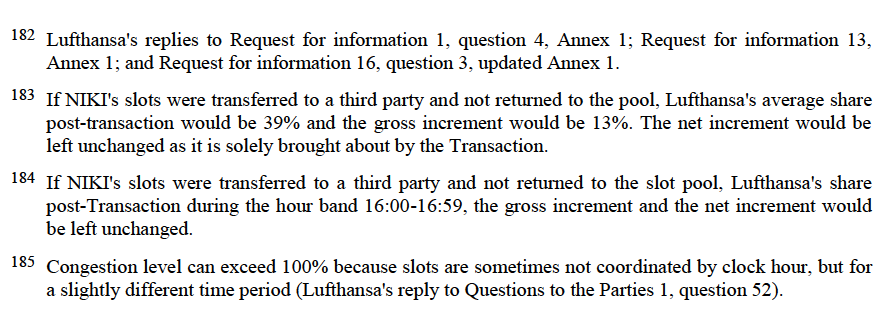







197 In Summer 2018 IATA Season, Lufthansa's slot holding would represent on average 35% of the airport capacity and during peak hours no more than 52% of the airport capacity. In Winter 2017/2018 IATA Season, Lufthansa's slot holding would represent on average 25% of the airport capacity and during peak hours no more than 40% of the airport capacity.



202 In Summer 2018 IATA Season, Lufthansa's slot holding would represent on average less than 17% of the relevant airport capacity and during peak hours no more than 28% of the relevant airport capacity. In Winter 2017/2018 IATA Season, Lufthansa's slot holding would represent on average less than 19% of the relevant airport capacity and during peak hours no more than 24% of the relevant airport capacity.
203 The factor related to the importance of slot holding and access to infrastructure at the relevant airports has already been assessed in section 8.2.1.
204 See Annual Report 2016 of Duesseldorf Airport: https://www.dus.com/~/media/fdg/duscom/konzern/unternehmen/zahlenundfakten/geschaeftsbericht/dusgb2016englsingle%20pages.pdf
205 Reply of Lufthansa to RFI 12 of 17 November 2017.
206 See emails from Lufthansa of 13 December 2017 and 15 December 2017 according to which (i) Lufthansa is transferred 254 LGW slots and 196 surplus slots, and (ii) 108 slots at Duesseldorf airport corresponds to two aircraft equivalents. Indeed, there are 17 hours per day at Duesseldorf airport where a carrier can utilise its aircraft; it is possible to fly four full rotations per day for which eight slots are necessary (four departures, four arrivals). The number of weekly slots needed for the full utilisation of an aircraft therefore amounts to 56. This number corresponds to the average utilisation of aircraft at Duesseldorf airport as intended in Eurowings' flight plan for Summer 2018 IATA Season.
207 22 aircraft for Eurowings, 4 aircraft for Germanwings, 4 aircraft for Lufthansa and 4 aircraft for SunExpress (see reply of Flughafen Duesseldorf to Q6 – Questionnaire to Airport Managers, question 2).
208 Reply of Flughafen Duesseldorf to Q6 – Questionnaire to Airport Managers, question 2.
209 Form CO, paragraph 1584.
210 For example: "Slots are the most critical issue. In Germany especially for DUS, which at the moment does not offer us the required slots to base one A320" (reply of an air carrier to Q2 – Questionnaire to Competitors, question 21.1).
211 For example: "The LH Group will get access to an extremely valuable slot portfolio at the most congested European airports e.g. Berlin-Tegel, Düsseldorf, Wien, Zürich, Palma de Mallorca, Ibiza, several Greek islands. All competitors have to follow the regular IATA process which means that they have no access to additional slots or just to a very limited number of slots as a new entrant" (reply of an air carrier to Q2 – Questionnaire to Competitors, question 34.2).
212 Reply of an air carrier to Q2 – Questionnaire to Competitors, question 34.2.
213 Reply of an air carrier to Q2 – Questionnaire to Competitors, question 21.1.
214 Lufthansa's reply to Request for information 1, question 19.
215 See paragraph 27 of the Explanatory Memorandum to the Commission Proposal for a Regulation of the European Parliament and of the Council on common rules for the allocation of slots at European Union airports (COM/2011/827 final of 01 December 2011).
216 See replies to Q2 – Questionnaire to Competitors, questions 34.1, 34.2 and 34.3.
217 See for example reply of an air carrier to Q2 – Questionnaire to Competitors, question 34.2: "With an overall level above 50% of all slots and 80% of all peak time slots, LH will be the only company at most slot regulated airports in Germany that is able to grow and adapt its offering to changed or increased demand. At the same time this massive slot portfolio will prevent other competitors from entering new routes or grow existing offers. Ultimately, LH will be the only airline that is in a position to satisfy a particular demand."
218 See paragraph 274 of this Decision.
219 The commitments of 5 December 2017 included additional measures related to Duesseldorf airport. They aimed at addressing the serious doubts resulting from Lufthansa's further reinforcement of its slot holding position at Duesseldorf airport, resulting from the acquisition of NIKI. The proposed measures consisted in the transfer of slots to TUIfly and to a suitable prospective entrant. Considering Lufthansa's decision not to acquire NIKI and the subsequent exclusion of NIKI from the scope of the Transaction (see paragraph 2 of this Decision), this Decision does not cover the additional measures proposed by Lufthansa prior to its decision not to acquire NIKI.
220 As a reply to Request for Information 25, Lufthansa confirmed that the schedule containing the list of slots to be transferred to Lufthansa does not contain any surplus slot.
221 Form RM, paragraphs 11-12.
222 OJ C 267, 22.10.2008, p. 1.
223 Case T-177/04 easyJet v Commission [2006] ECR II-1931, paragraph 128 et seq.
224 If NIKI's slots were transferred to a third party and not returned to the slot pool, Lufthansa's share post-Transaction would be 52%. The net increment would be left unchanged as it is solely brought about by the Transaction.
225 If NIKI's slots were transferred to a third party and not returned to the slot pool, Lufthansa's share post-Transaction would be 50%. The net increment would be left unchanged as it is solely brought about by the Transaction.
226 Replies to R2 – Market test of commitments to Competitors, questions 8.1 and 8.2.
227 Replies to R2 – Market test of commitments to other market participants, question 8.1.
228 Replies to R2 – Market test of commitments to other market participants, question 8.2.1. Some of the other market participants stated that, if fewer slots were acquired by Lufthansa and more slots went to the pool, this would allow other airlines to apply for the slots. However, these respondents did not substantiate their reply and their replies seem to disregard the fact that many of the slots that would return to the pool could be obtained by Lufthansa, based on its existing high slot holding.
229 See emails from Lufthansa of 13 December 2017 and 15 December 2017. Lufthansa would, under the commitments of 15 December 2017, acquire 108 slots at Duesseldorf airport, corresponding to two aircraft equivalents. Indeed, there are 17 hours per day at Duesseldorf airport where a carrier can utilise its aircraft; it is possible to fly four full rotations per day for which eight slots are necessary (four departures, four arrivals). The number of weekly slots needed for the full utilisation of an aircraft therefore amounts to 56. This number corresponds to the average utilisation of aircraft at Duesseldorf airport as intended in Eurowings' flight plan for Summer 2018 IATA Season
230 If NIKI's slots were transferred to a third party and not returned to the slot pool, Lufthansa's slot holding post-Transaction would be 48%. The net increment would be left unchanged (1%) as it is solely brought about by the Transaction.
CASE COMP/M.8633 - Lufthansa / certain Air Berlin assets
COMMITMENTS TO THE EUROPEAN COMMISSION
Pursuant to Article 6 (2) of Council Regulation (EC) 139/2004 (“Merger Regulation”), Deutsche Lufthansa AG (“Lufthansa”) hereby submits the following commitments (the “Commitments”) to enable the European Commission (“Commission”) to declare the proposed acquisition by Lufthansa of Luftfahrtgesellschaft Walter mbH (“LGW”) (the “Proposed Transaction”) from Air Berlin PLC, Air Berlin PLC & Co Luftverkehrs KG, and NL AB Beteiligungs GmbH (“Air Berlin”) (together, “the Parties”) compatible with the internal market and the EEA Agreement by a decision pursuant to Article 6(1)(b) of the Merger Regulation (“Decision”).
These Commitments shall take effect upon the date of the adoption of the Decision. The Commitments are compatible with the common market and will be binding on Lufthansa, its subsidiaries, successors and assigns. These Commitments are offered exclusively in the context of the Proposed Transaction and are without prejudice to the position of Lufthansa in other cases examined by the European Commission.
This text shall be interpreted in light of the Decision to the extent that the Commitments are attached as conditions and obligations, in the general framework of European Union law, in particular in light of the Merger Regulation, and by reference to the Commission Notice on remedies acceptable under Council Regulation (EEC) No. 139/2004 and under Commission Regulation (EC) No. 802/2004.
DEFINITIONS
For the purpose of the Commitments, the terms below shall have the following meaning:
DUS: DUS refers to Duesseldorf Airport.
Effective Date: The Effective Date refers to the date of the Decision.
Slot: The term Slot refers to the arrival and departure at a scheduled time available or allocated to an aircraft movement on a specific date at each airport of origin or destination as defined in Article 2(a) of Council Regulation (EEC) No 95/93 (as amended).
1. COMMITMENTS RELATING TO THE ACQUISITION OF LGW
1.1. LIMITATION OF LGW SLOTS AT DUS FOR IATA SUMMER SEASON
1.1.1. Lufthansa commits to amend the Agreement for the Sale and Purchase of the AB Touristic and LGW Wet-Lease Business entered into by Lufthansa, Air Berlin, and related entities on 13 October 2017 (“SPA”) to the effect that Lufthansa will limit DUS Slots for IATA summer season acquired through LGW to Slots for two aircraft equivalents (the “LGW Slots”). A list of these Slots is provided in Schedule 1 to the Commitments.
1.1.2. Lufthansa commits not to acquire Slots from Air Berlin in a separate transaction.
1.2. REPORTING
1.2.1. No later than 10 working days after the Effective Date, Lufthansa shall transmit to the Commission the documents evidencing the amendments to the SPA referred to in Section 1.1.
2. GENERAL PROVISIONS
2.1.1. These Commitments shall take effect on the Effective Date.
2.1.2. If the Transaction is abandoned, unwound or otherwise terminated, these Commitments shall automatically cease to apply.
Brussels, 15 December 2017